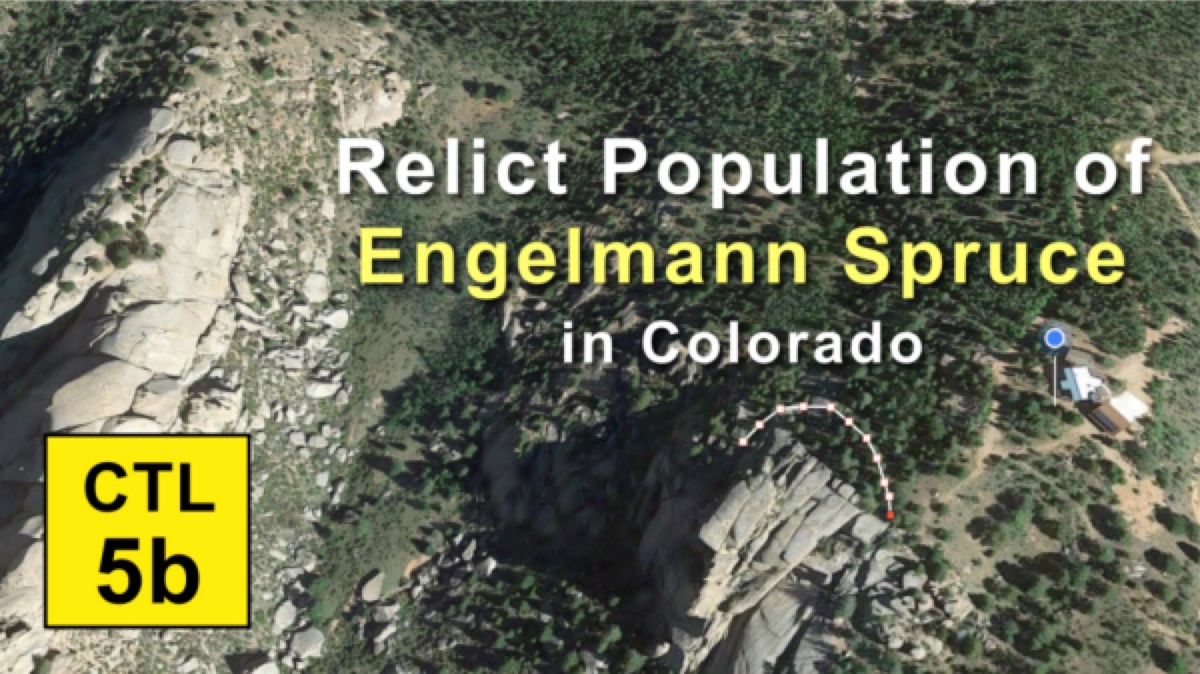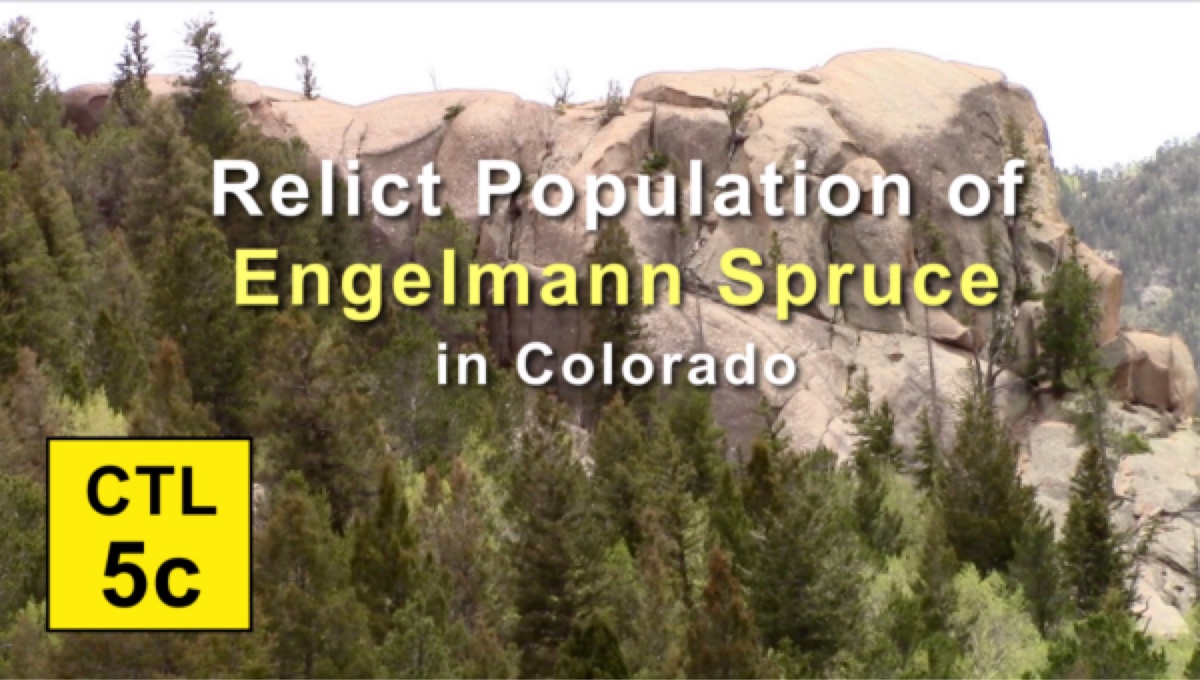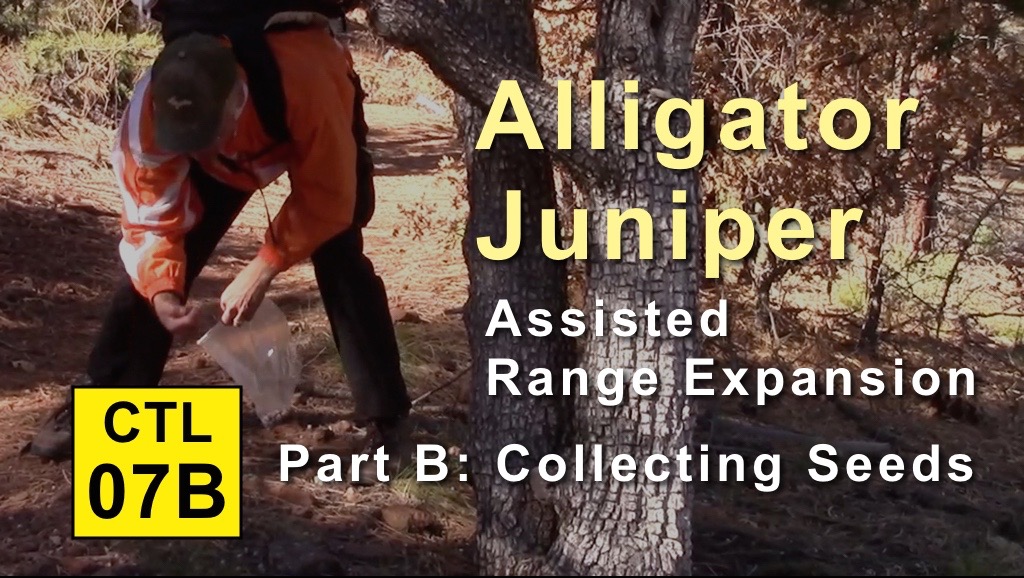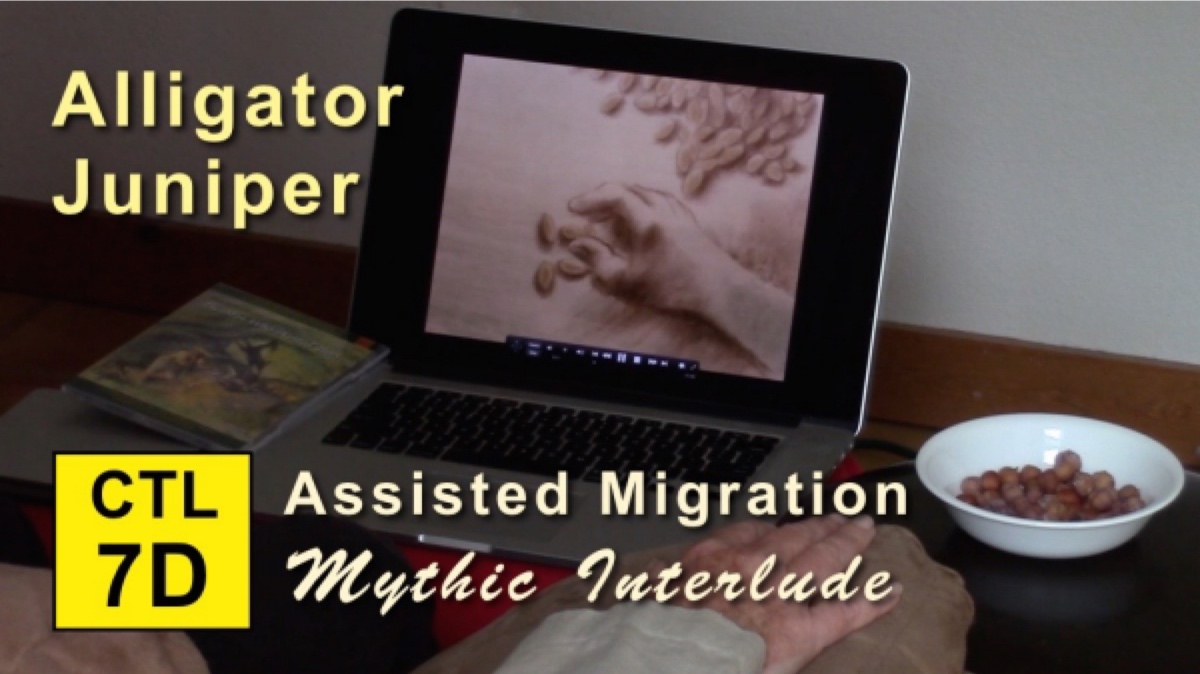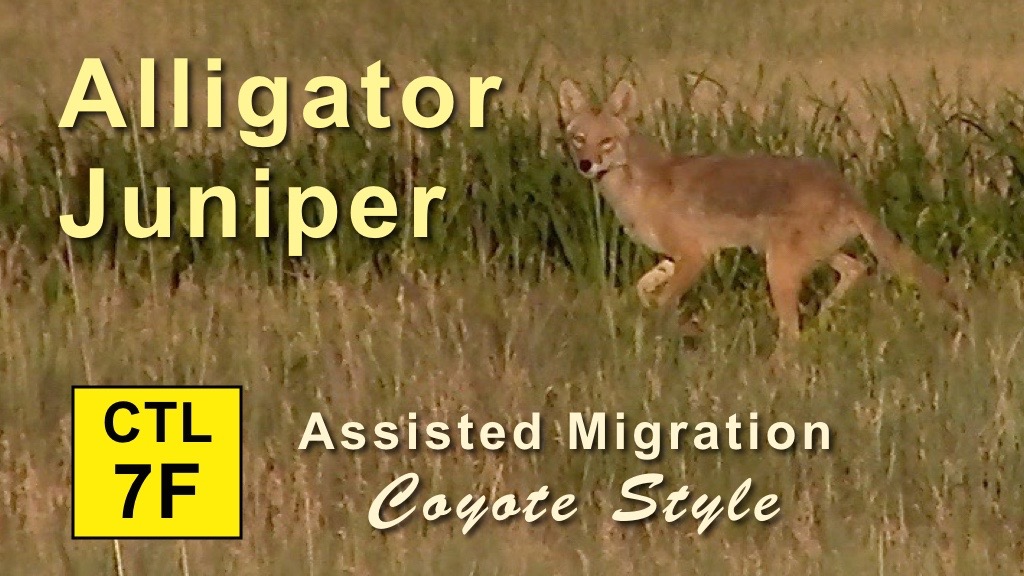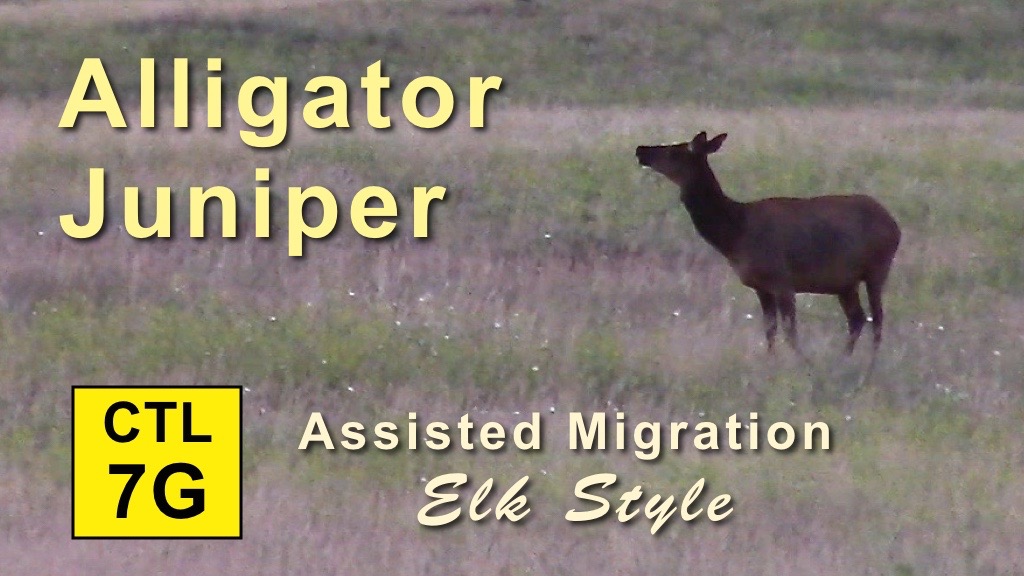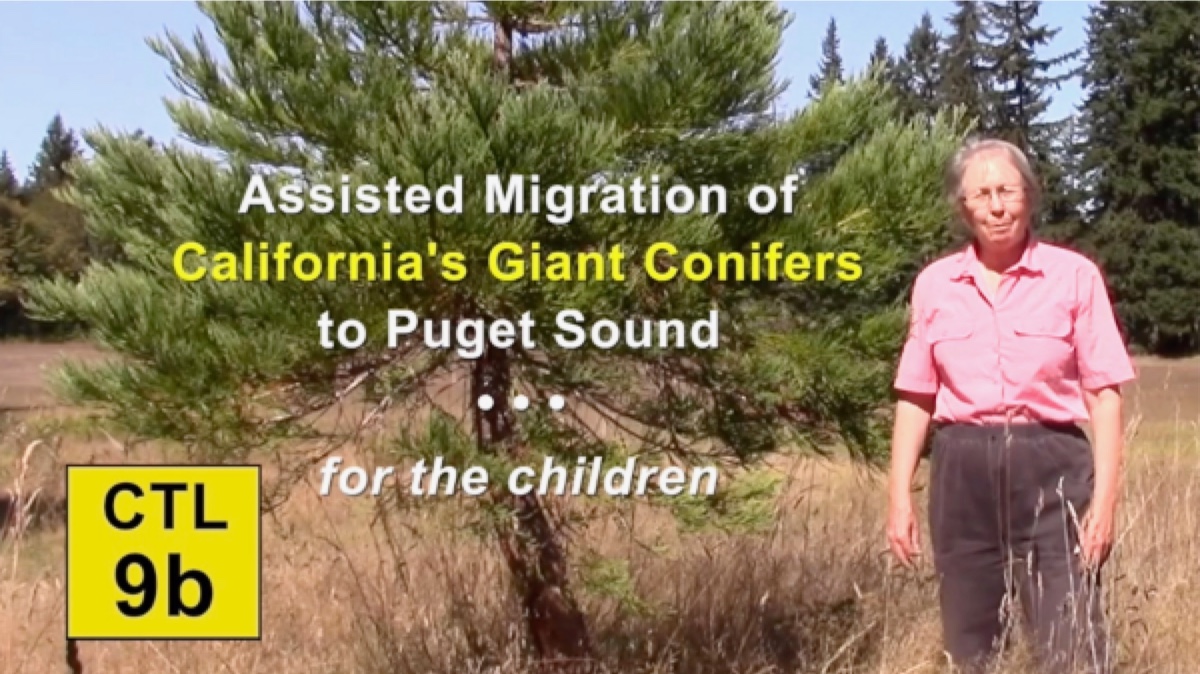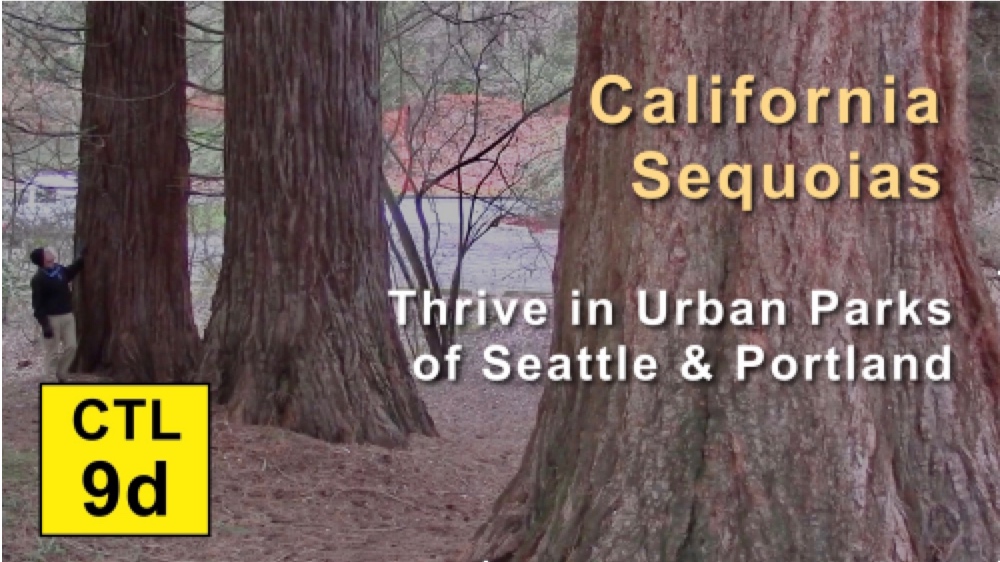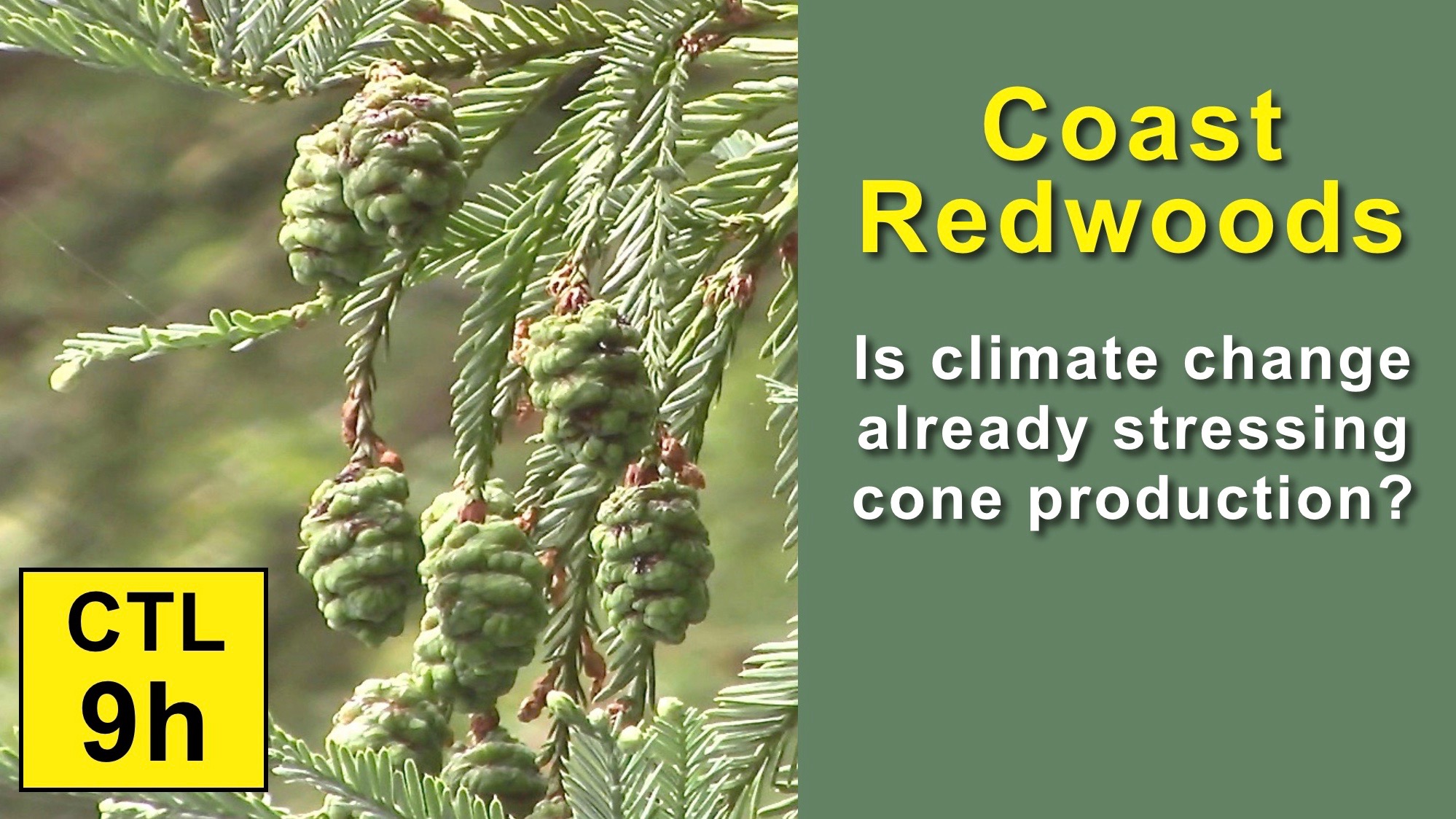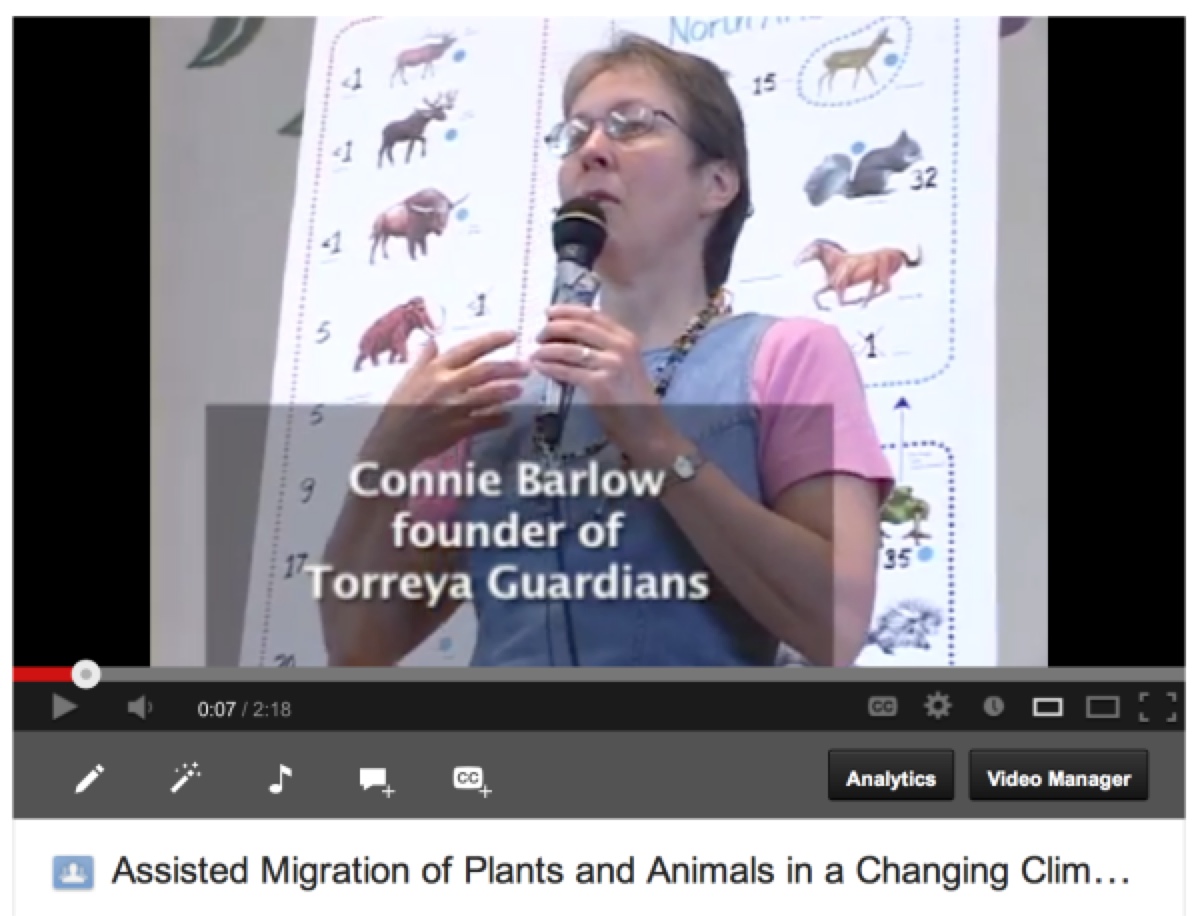|
Climate, Trees, and Legacy
Educational VIDEO series to explore the prospects of human-assisted migration
("assisted colonization") of America's forest trees in this time of rapid climate change
with CONNIE BARLOW

If you have time for only one video, choose by REGION:
• PLAYLIST for "Helping Forests Walk" (click on image above, and then part 01 Introduction)
• pt 3 if you live in the desert Southwest
• pt 5 if you live in the Rocky Mountain States
• pt 6 for east of the Mississippi
• pt 9 for n. California and Pacific Northwest
ACADEMICS, historians, and professional conservationists or resource managers:
• pt. 8 Connie's 2015 talk at the Forestry school at Michigan Technological University
ASSISTED MIGRATION ACTIVISM talks by Connie Barlow:
• 2014 - Original INTRODUCTION to the whole series
• 2014 - Bookstore talk in Prescott AZ (edited and updated in 2021)
• 2014 - Community talk in Durango CO
• 2016 - "Assisted Migration: Act Now!"
Most recent videos (2021-25)
by Connie in "Helping Forests Walk" series
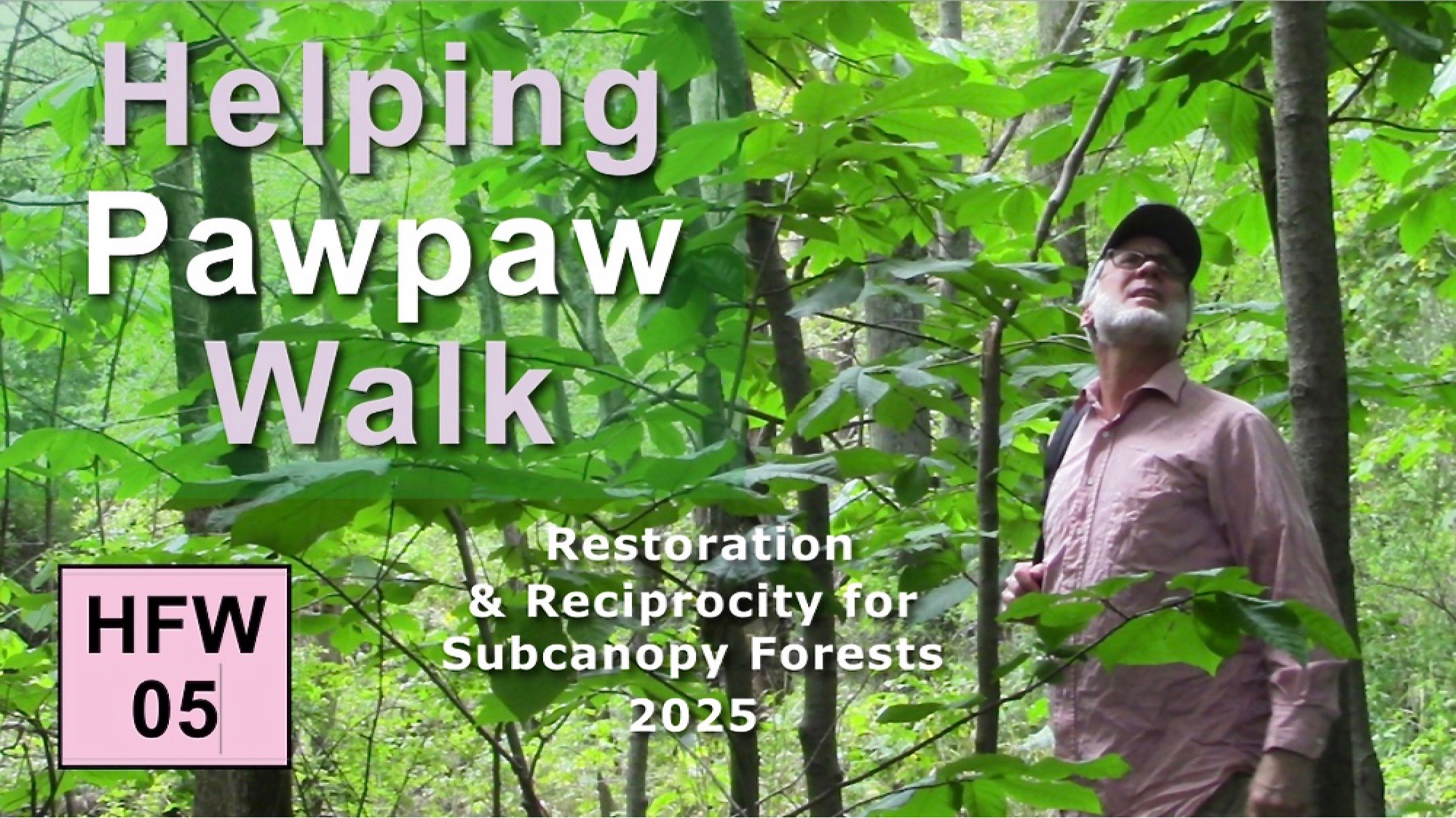 |
|
Helping Pawpaw Walk: Restoration and Reciprocity for Subcanopy Forests (Michigan, 2025)
This experiment in utilizing native Pawpaw for subcanopy restoration began in 2021. Plantings amplified in 2025 when Connie Barlow planted some 1,300 seeds. Here she explores "a minimalist approach to ecological restoration" of this post-industrial bottomland along the Huron River, culminating with an act of reciprocity toward curious rodents.
58 minutes - filmed September 9, 2021. WATCH |
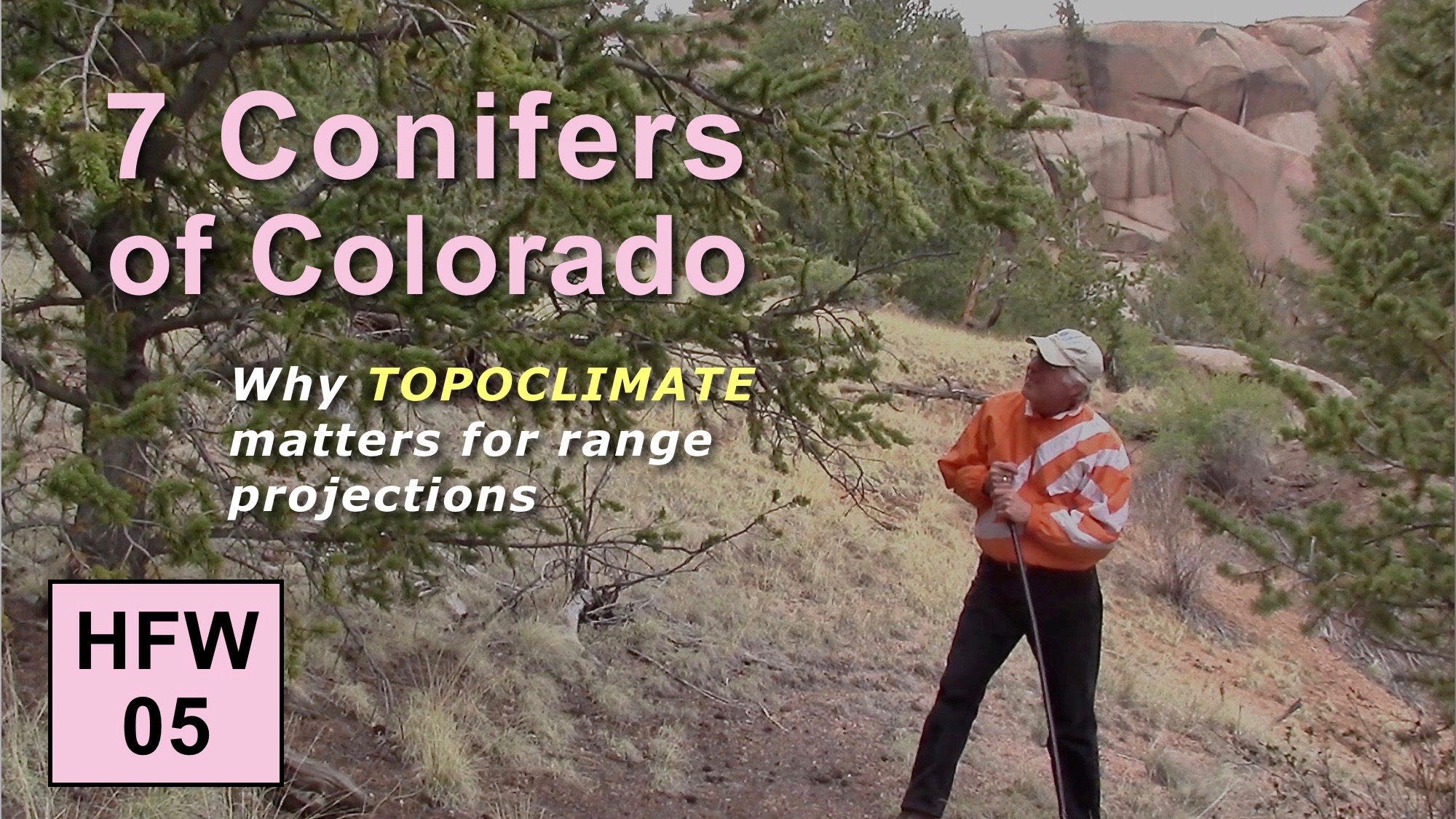 |
|
"7 Conifers of Colorado - Why Topoclimate Matters for Range Projections".
Connie Barlow filmed wild populations of 7 conifer tree species in 2017 — all within a few hundred yards of one another. Topoclimate is a crucial consideration in highly complex topographies, such as this site in the Colorado Rockies, 9400-feet elevation. In live commentary added in 2022, Connie makes the case for "assisted migration" of Bristlecone Pine.
48 minutes - published February 2022 WATCH
|
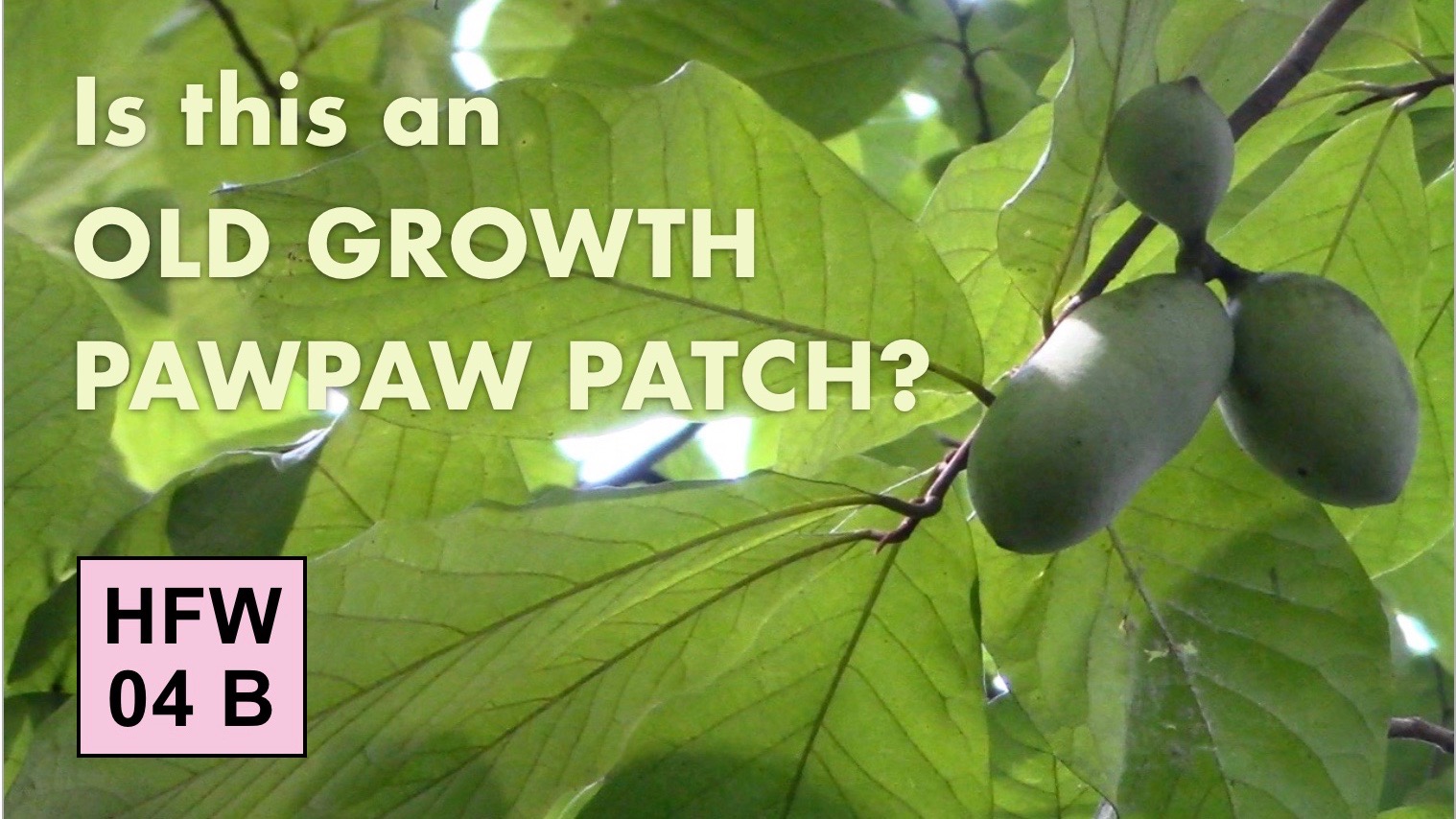 |
|
Is this an Old-Growth Pawpaw Patch? (Michigan, 2021)
In the previous episode, "Helping Subcanopy Trees Migrate," Connie suggested that a wild pawpaw patch she explored two months earlier has characteristics of old growth. Here is the field footage for others to "explore" this site and make their own interpretations.
36 minutes - filmed September 9, 2021. WATCH |
 |
|
"Helping Subcanopy Trees Migrate" features two subcanopy species of the eastern USA. Pawpaw, while having a long north-south reach in its historic range, can benefit from "assisted range expansion" northward. Florida Torreya is an endangered glacial relict for which citizens, including Connie, have done what the official recovery program implementers have been unwilling to do — restore its health by nothing more difficult than planting seeds well to the north.
Indigenous values are advocated as well as the "natural history" style of observation and interpretation.
50 minutes - published November 2021. WATCH
|
 |
|
"Thinking Like a Yew" is the title Connie chose for the third episode of her "Helping Forests Walk" series. (It echoes Aldo Leopold's "Thinking Like a Mountain.")
This video is an assemblage of forestry videos Connie took of wild yew species in western (Oregon and California) and eastern (Michigan and New York) North America. She hopes it will help colleagues in Europe and China have new ideas for assisting their own native yews in climate migration.
73 minutes - published June 2021. WATCH
|
 |
|
REPOSTING of a TALK Barlow delivered September 2015 at Michigan Technological University, the School of Forest Resources and Environmental Science. It was originally posted on youtube titled, "Foresters Outpace Conservation Biologists in Climate Adaptation."
Speaking to faculty and students, this was an opportunity for Barlow to present the history of the "assisted migration" controversy — highlighting the reasons why foresters have already taken actions where conservation biologists fear to tread.
60 minutes - published October 24, 2015 WATCH |
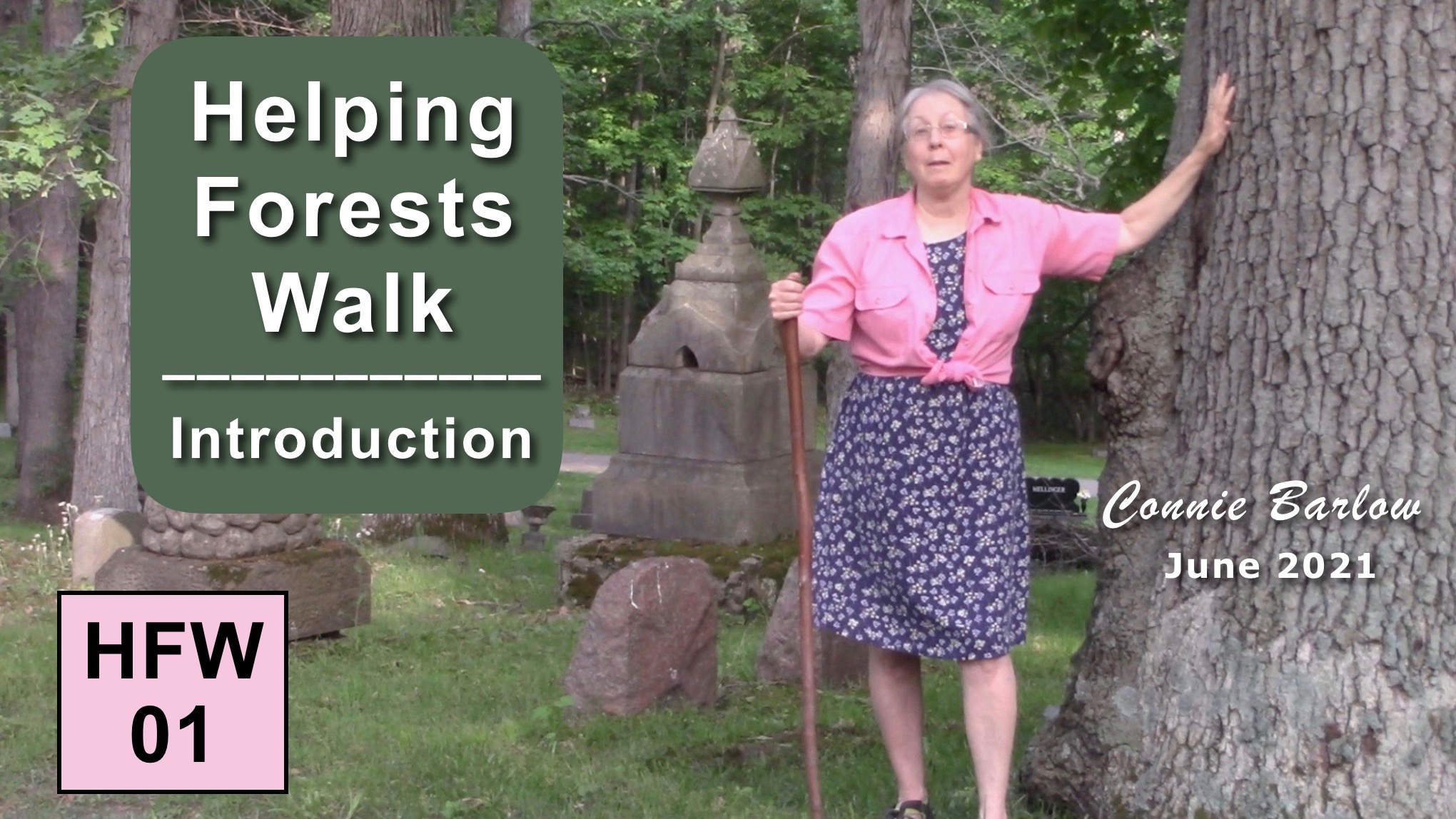 |
|
Retired to her home state of Michigan, Barlow launched a new video series: "Helping Forests Walk". Episode 1 - Introduction begins this more reflective series on the topic of "assisted migration" than her 2014-2020 video series filmed across America: "Climate, Trees, and Legacy".
This new series builds upon her founding of Torreya Guardians in 2004, which was the first group to help a climate endangered tree move poleward. This series will feature traditional natural history ways of observing and interpreting as a possible bridge between indigenous and modern science.
52 minutes - published June 2021 WATCH
|
Full series in CHRONOLOGICAL ORDER
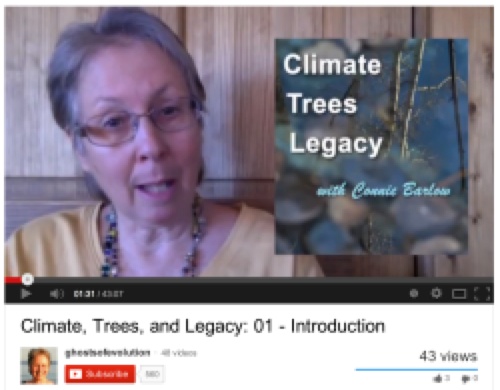 |
|
Pt. 1: INTRODUCTION (still highly recommended in 2023)
This is a learning and action series for helping trees adapt to climate change. "Assisted migration" in a time of unprecedented climate shift will be increasingly necessary in the decades ahead.
Foresters can create the maps to show us where species will need to move. But we citizen naturalists will play a complementary role in ensuring that the full diversity of genotypes keeps pace with a warming and drying continent. Explains why a "deep-time" understanding is crucial. Poses 3 overall questions for series to explore.
43 minutes - published January 4, 2014. WATCH |
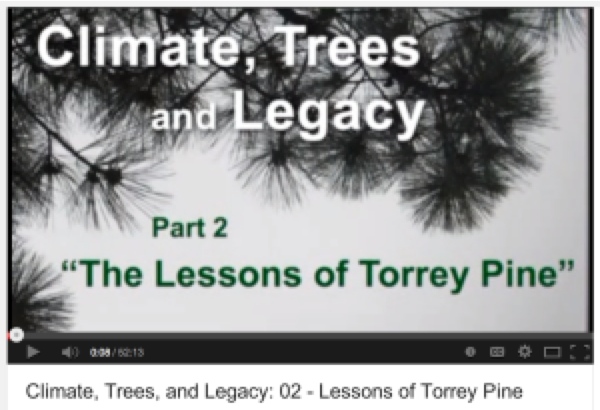 |
|
Pt. 2: LESSONS OF TORREY PINE
The focal tree for episode 2 is America's rarest pine tree: the Torrey Pine of the foggy coast of southern California. Lessons learned: (1) In this case, size of habitat doesn't matter; San Diegoans are planting and watering it on lawns and street-sides. (2) Experience does matter; though reading scientific papers is crucial, so is ground truthing. The venerable tradition of nature study and the kinds of simple outdoor experiments that Darwin excelled in will become increasingly important as plant zones head north faster than tree species can follow.
53 minutes - published March 18, 2014. WATCH |
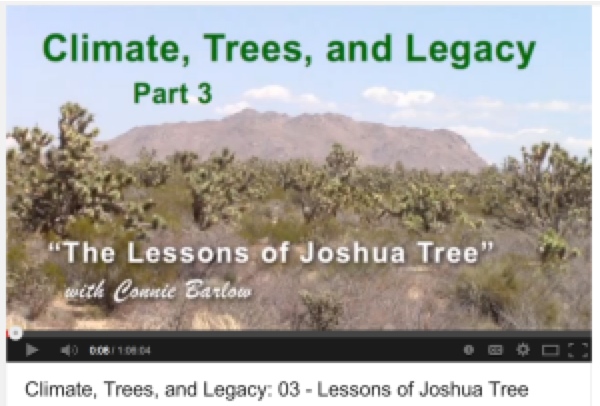 |
|
Pt. 3: LESSONS OF JOSHUA TREE
The focal tree for episode 2 is Joshua Tree of the Mojave Desert. Lessons discerned:
(1) Experiment with assisted migration to learn the actual northern range limits of Joshua Tree (Yucca brevifolia) in today's climate.
(2) People get possessive about their trees.
(3) Value biodiversity over "native range".
The March 2014 AAAS climate report, "What We Know", is highlighted, along with the 2014 Working Group II report of the IPCC: "Impacts, Adaptation, and Vulnerability."
66 minutes - published April 11, 2014. WATCH |
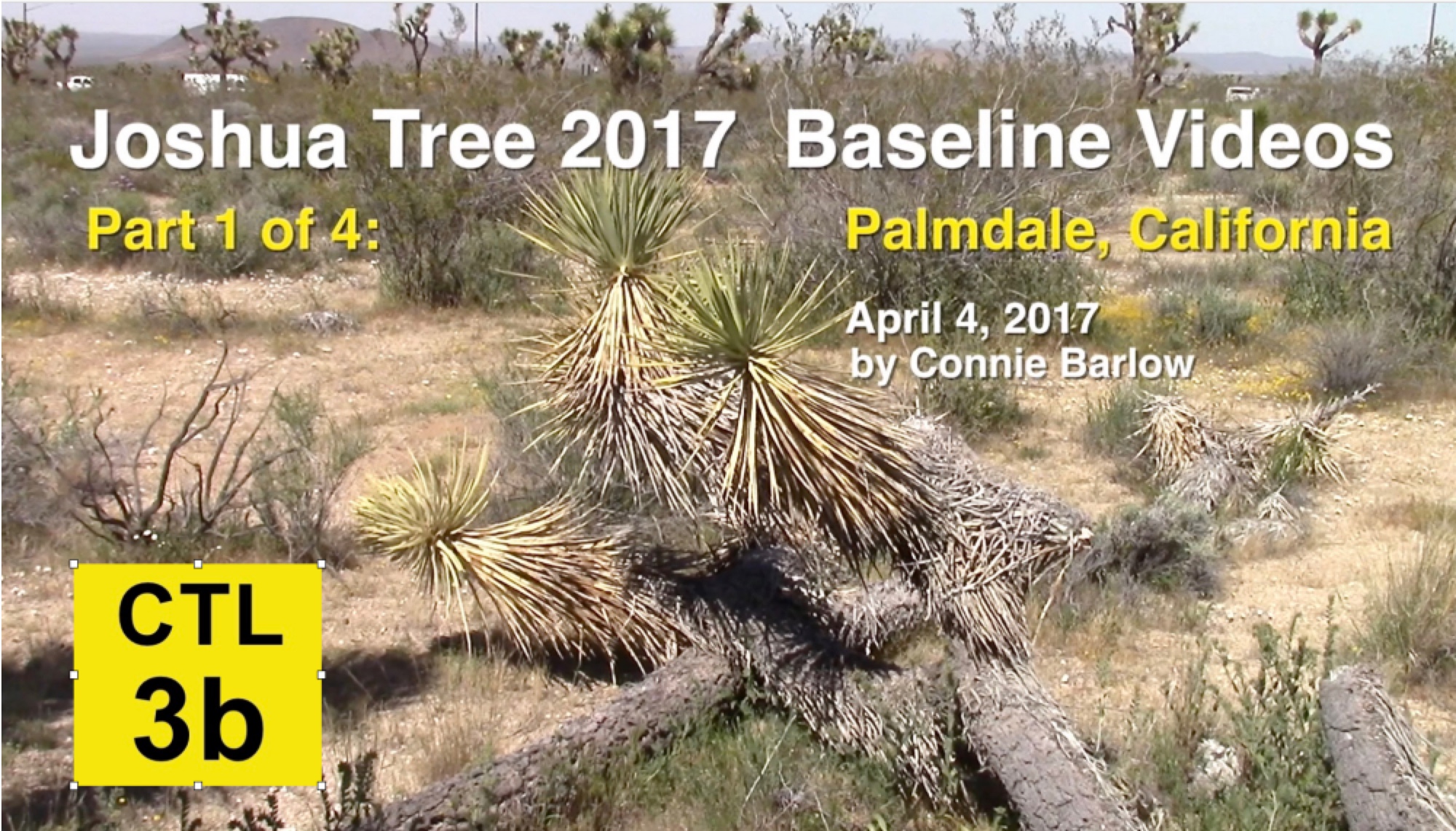 |
|
Pt. 3B: Baseline Documentation: Palmdale CA (2017)
Pt 1 of a 4-part series filmed in April 2017 by Connie Barlow for the purpose of visually recording the ecological "baseline" conditions of Joshua Trees in specific areas. Baseline documentation is crucial for scientifically assessing habitat viability (and degradation) for Joshua Trees in future decades, owing to anthropogenic climate change.
8 minutes - filmed April 4, 2017. WATCH |
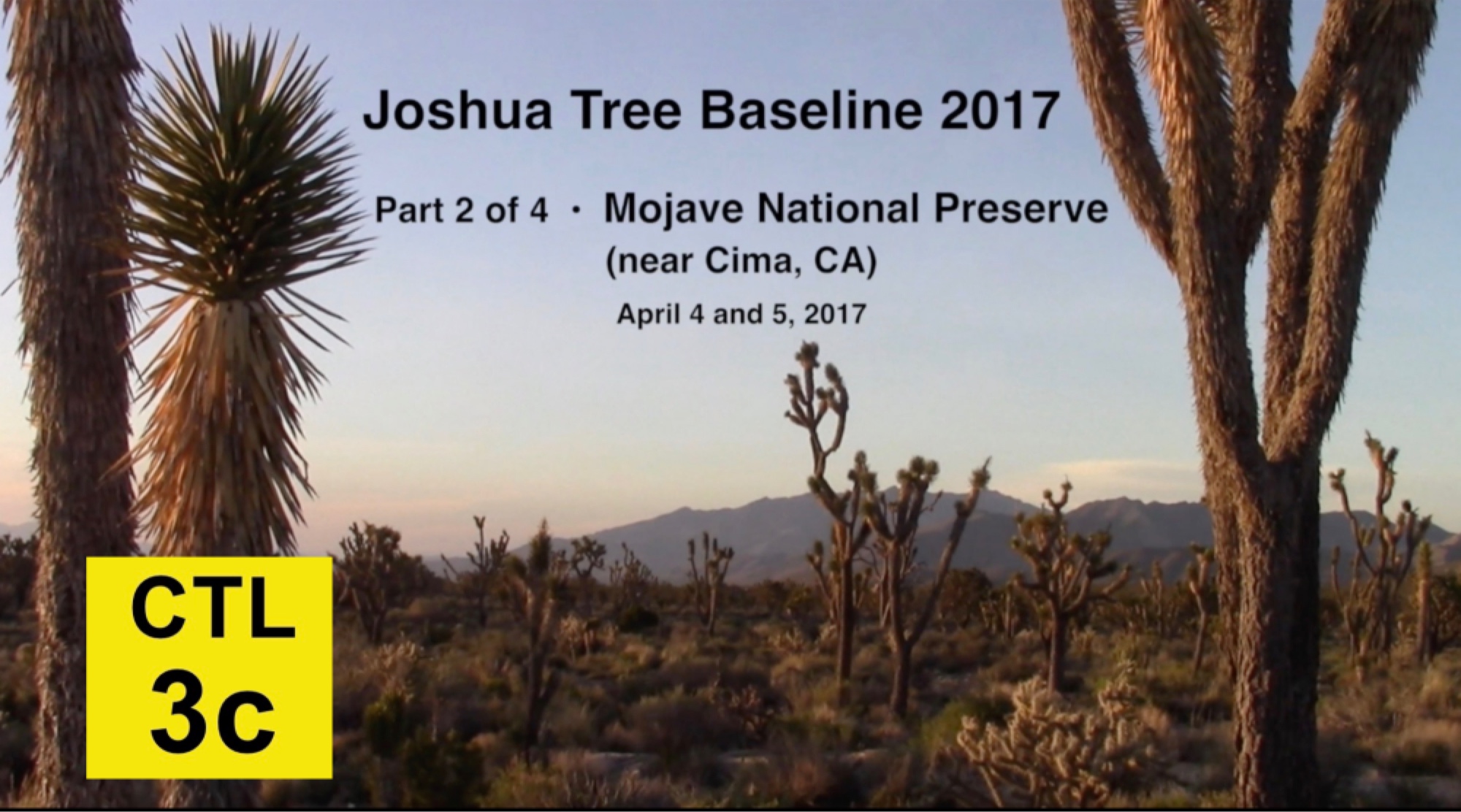 |
|
Pt. 3C: Baseline Documentation: Mojave Preserve (2017)
Pt 2 of a 4-part series filmed in April 2017 by Connie Barlow for the purpose of visually recording the ecological "baseline" conditions of Joshua Trees in specific areas. The section of Mojave National Preserve (along Cima Rd) recorded here is the richest Joshua Tree woodland of all.
17 minutes - filmed April 4-5, 2017. WATCH |
UPDATE 2021: The above baseline video of Mojave Preserve can now help for monitoring restoration following the August 2020 Cima Dome fire that killed probably most of the trees in this video. And excellent report on the damage and prospects for recovery is, "Joshua Trees: An Uncertain Future For A Mojave Desert Icon" by Hilary Clark.
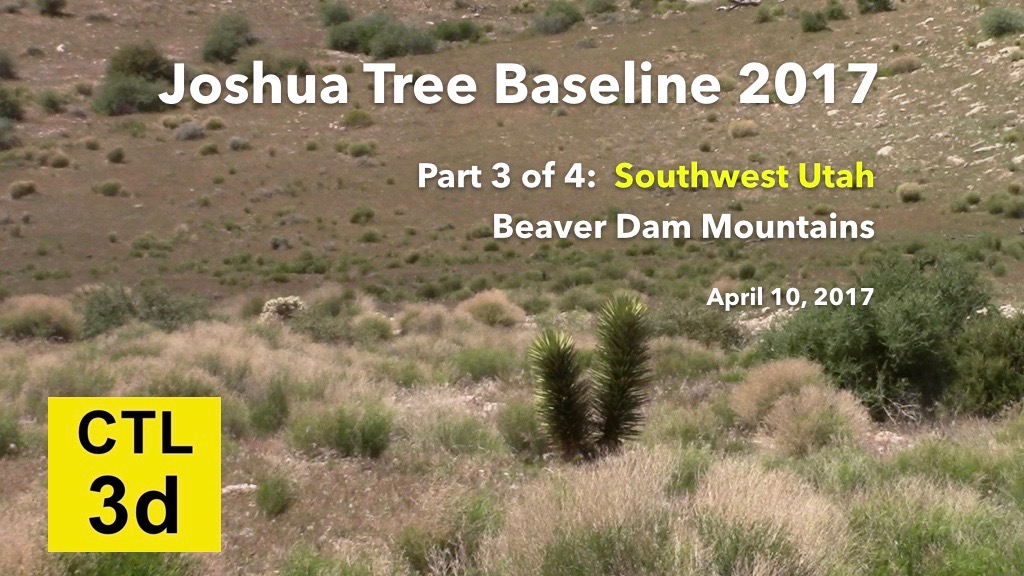 |
|
Pt. 3D: Baseline Documentation: SW Utah (2017)
Baseline documentation of this northeastern-most population of Joshua Trees (Beaver Dam Mountains, SW Utah) is crucial for (a) understanding the generational structure and health of outliers and (b) for being able to compare shifts in population health and structure in the decades ahead.
30 minutes - filmed April 10, 2017. WATCH |
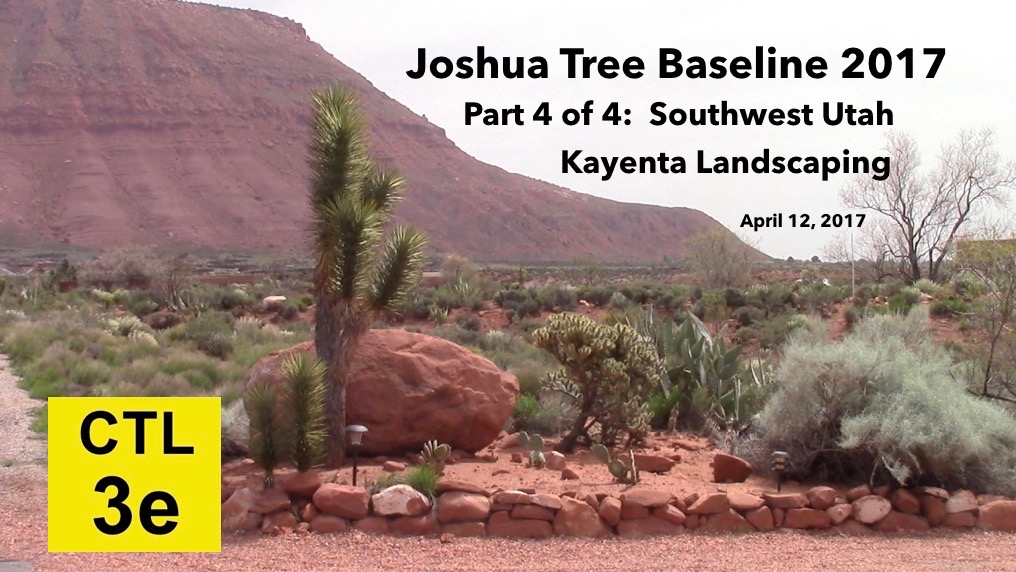 |
|
Pt. 3E: Baseline Documentation: SW Utah Landscaping
Assisted migration for Joshua Trees is already underway — inadvertently. Landscapers well beyond this species' wild populations routinely plant Joshua Tree as a beloved native. Here Connie records the plantings in Kayenta subdivision near St. George, Utah, while noting the importance of gathering oral histories of the plantings.
18 minutes - filmed April 12, 2017. WATCH |
APRIL 2021 UPDATE: An extreme drought in parts of the American Southwest is resulting in all species of juniper showing significant mortality: "Juniper tree die-off in Arizona linked to drought, Forest Service says". Is this a sign that the time may have arrived to assist Joshua Tree in expanding its range?
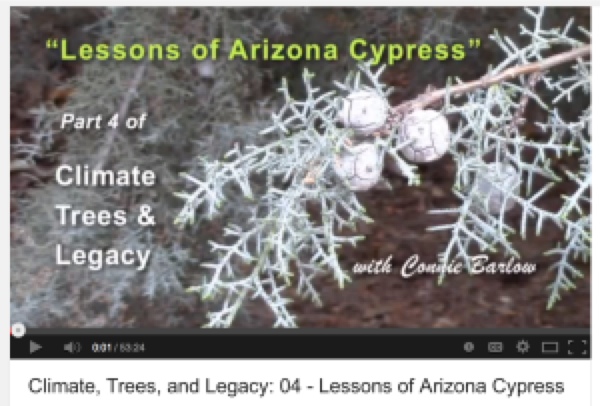 |
|
Pt. 4: LESSONS OF ARIZONA CYPRESS
The focal tree for episode 4 is Smooth Arizona Cypress.
Lessons discerned:
(1) The landscaping business can do no-cost assisted migration. (2) Species with disjunct populations have special needs. (3) Taxonomic "Lumpers" v. "Splitters" affect conservation views.
(4) Big difference bt. natural v. human rates of climate change.
53 minutes - published June 13, 2014. WATCH |
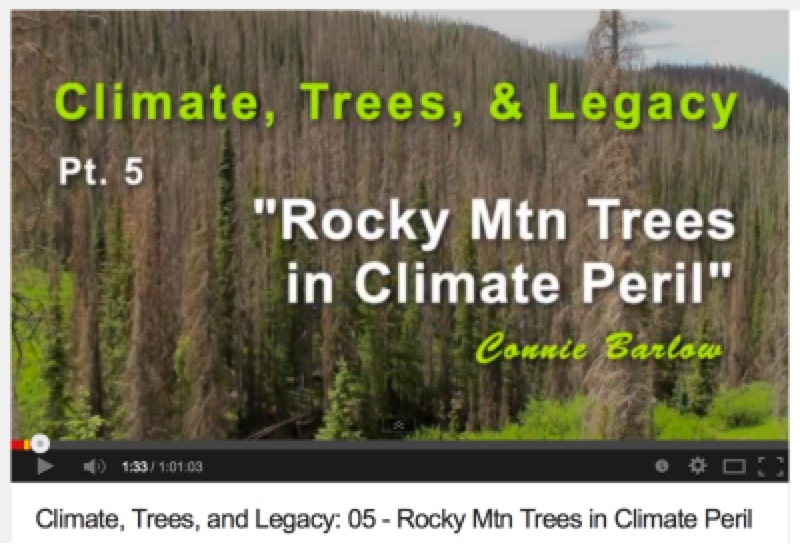 |
|
Pt. 5: ROCKY MOUNTAIN TREES IN CLIMATE PERIL
Ten conifers in Colorado are the focal trees of episode 5.
Lessons discerned:
(1) Worldview shifts can happen quickly
(2) Climate change becomes real locally
(3) Opportunities to act are crucial
(4) Climate effects on old-growth and wilderness forests will be heartbreaking.
61 minutes - published July 5, 2014. WATCH |
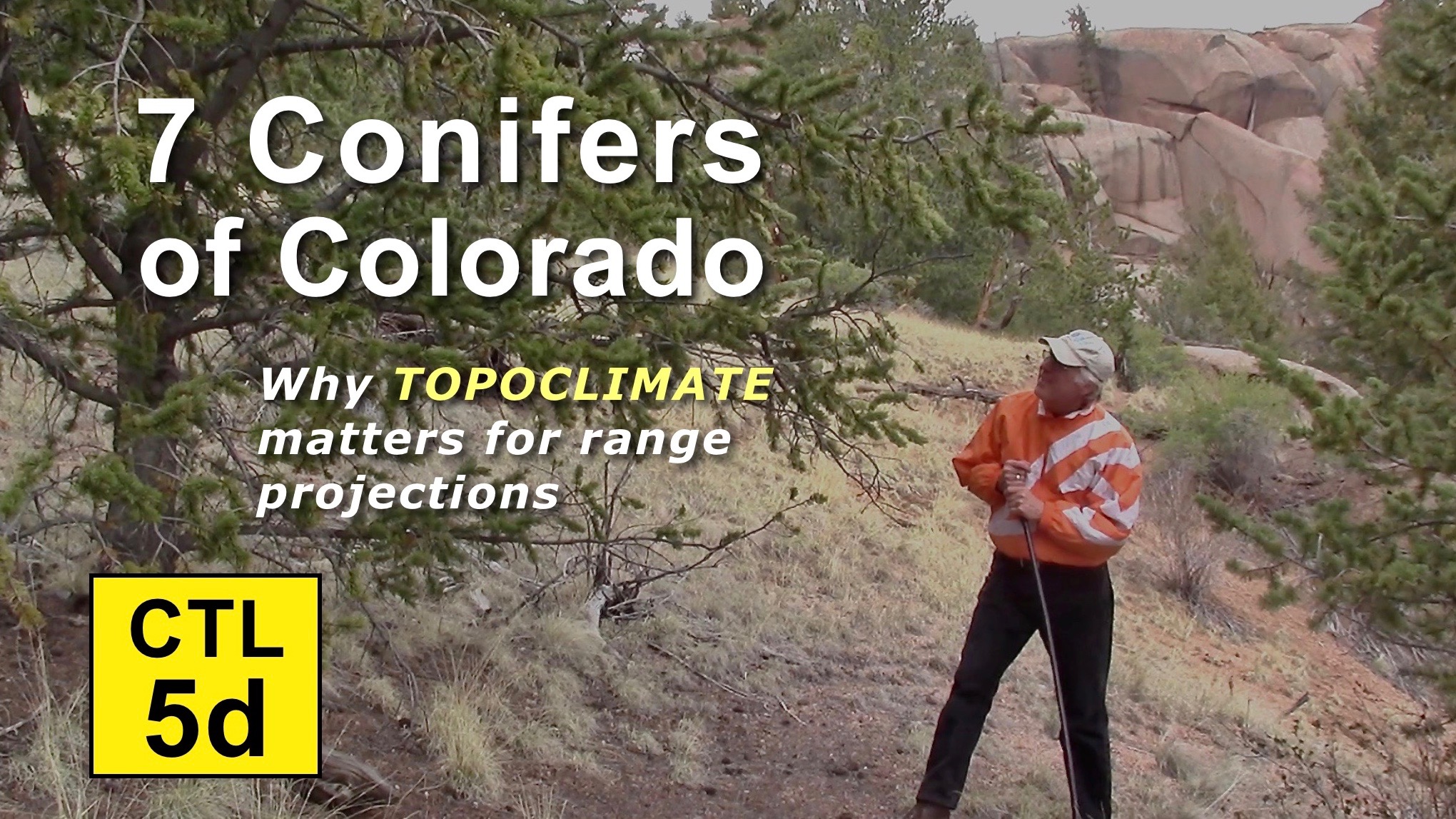 |
|
"Conifers of Colorado - Why Topoclimate Matters for Range Projections".
Seven conifer tree species are all within a few hundred yards of one another. Topoclimate is a crucial consideration in highly complex topographies, such as this site in the Colorado Rockies, 9400-feet elevation. Connie makes the case for "assisted migration" of Bristlecone Pine.
48 minutes - published February 2022 WATCH
|
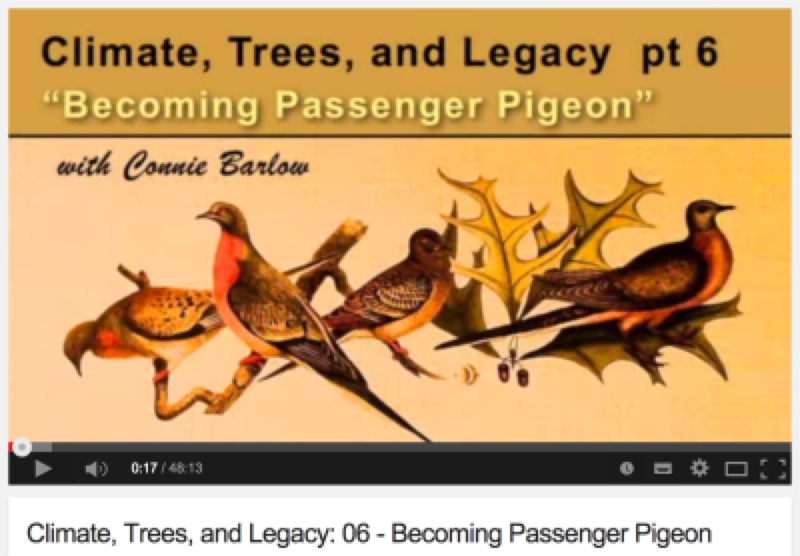 |
|
Pt. 6: BECOMING PASSENGER PIGEON
Includes footage of a 2014 pilgrimage Connie made to the Smithsonian exhibit commemorating the 100th anniversary of the death of the last Passenger Pigeon.
Lessons discerned:
(1) We need to distinguish among 3 forms of assisted migration:
Assisted population migration
Assisted range expansion
Assisted species migration
(2) The Passenger Pigeon, once a major seed disperser, is extinct
(3) We therefore need to "Become Passenger Pigeon"
48 minutes - published November 8, 2014. WATCH |
OAK TREE UPDATE 2020: A must-read article on the evolutionary journey across geographies, climates, and ecological encounters of the oak genus (Quercus) elevates one's amazement — both about the majesty and brilliance of this multi-lineage tree form and about what genomic science, when coupled with natural history observations, can achieve. It is "How Oak Trees Evolved to Rule the Forests of the Northern Hemisphere", by Andrew L. Hipp, Paul S. Manos, and Jennine Cavender-Bares, August 2020, Scientific American.
This 2009 paper, "Reassessing the Importance of Granivorous Pigeons as Massive, Long-Distance Seed Dispersers", confirms that PP, in combination with its predators, could have facilitated long-distance seed dispersal via intact seeds carried in its large crop. See also this 1986 paper by Sara Webb: "Potential role of passenger pigeons and other vertebrates in the rapid Holocene migrations of nut trees", which says, "This bird's abundance, capacity for delayed digestion, and nomadic habits strongly suggest an occasional seed dispersal role."
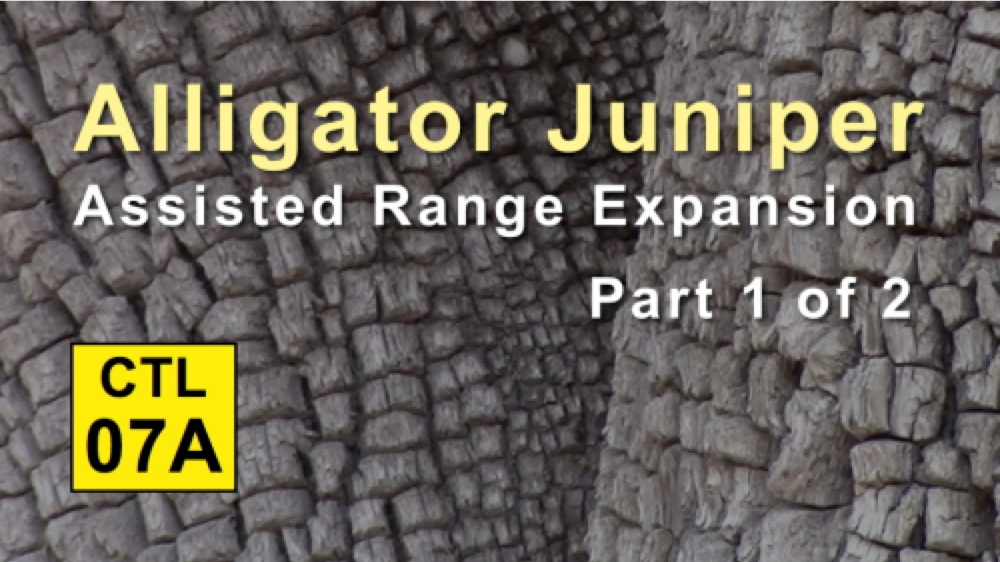 |
|
Pt. 7A: ALLIGATOR JUNIPER ASSISTED RANGE EXPANSION
Part 1 of 2 (pt 2 will be completed late 2015 or 2016)
Background for an actual range expansion test planting from a dwindling population of Alligator Juniper near Albuquerque NM (6,800 ft elevation) to a private open forested site in s. Colorado (8,300 ft elevation).
35 minutes - published March 22, 2015. WATCH |
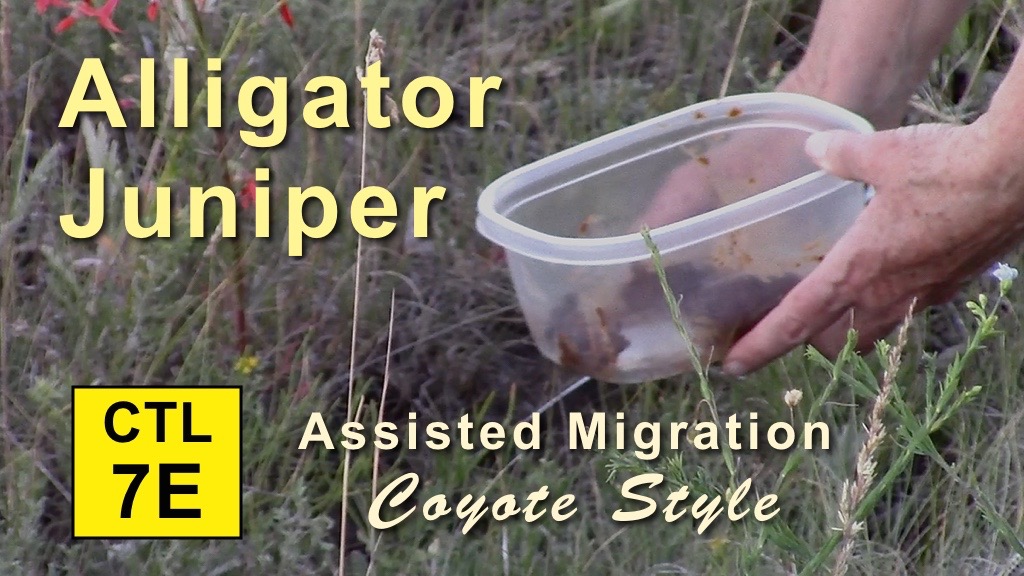 |
|
Pt. 7E: Assisted Migration Coyote Style (Alligator Juniper)
First episode in a series filmed at Edward Sargent Wildlife Management Area (Chama, NM). Coyote style means that Connie ingested the seeds, then "inadvertently" planted them while hiking. Elk style plantings (in later episodes) are "controls" — testing whether digestion is helpful for assisted migration.
40 minutes - published August 30, 2016. WATCH |
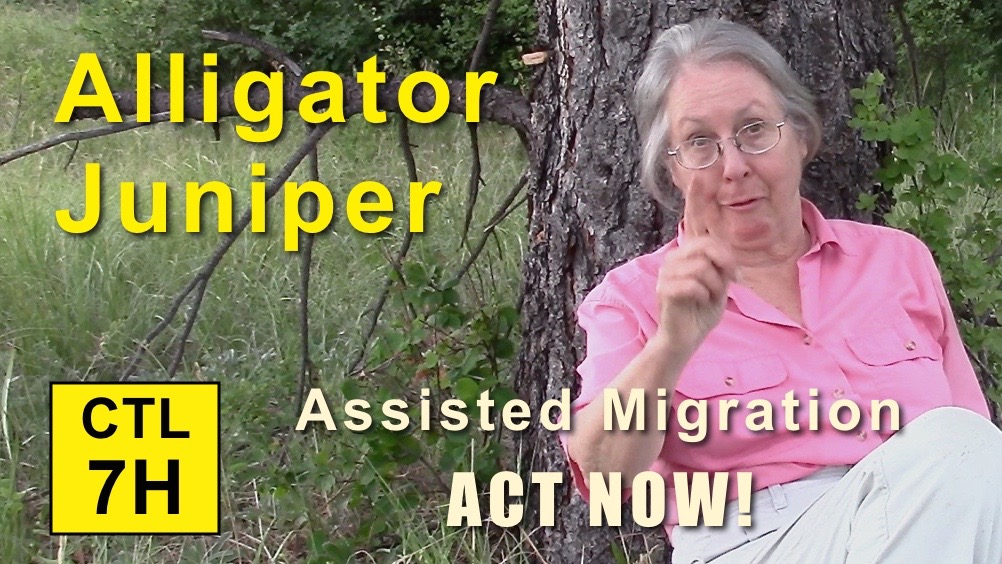 |
|
Pt. 7H: Assisted Migration: ACT NOW! (Alligator Juniper)
STRONG ADVOCACY. Midway through the video sequence filmed near Chama NM, Connie explains why she undertook this "assisted migration" action, including the history of her work with Torreya Guardians, and advocates for other naturalists to voluntarily (and responsibly) embark on projects for other tree species. Filmed August 1, 2016
22 minutes - September 10, 2016. WATCH or LISTEN |
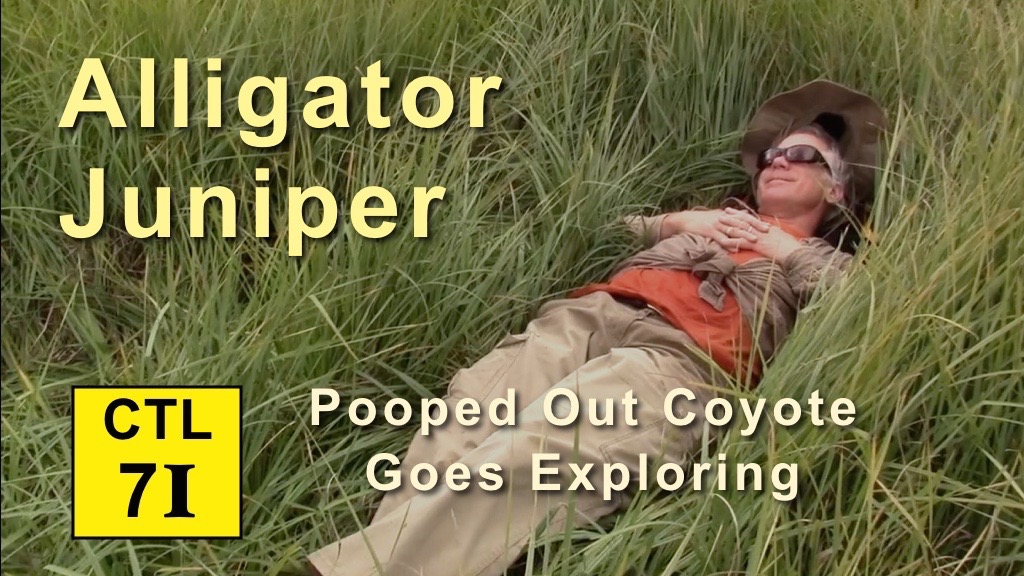 |
|
Pt. 7I: Pooped Out Coyote Goes Exploring
Last planting "coyote-style" of Alligator Juniper seeds. The remainder of the video records "baseline" ecological data of the entire valley area — for comparison with how climate changes vegetation in future decades. Filmed August 2, 2016
40 minutes - published December 28, 2016. WATCH |
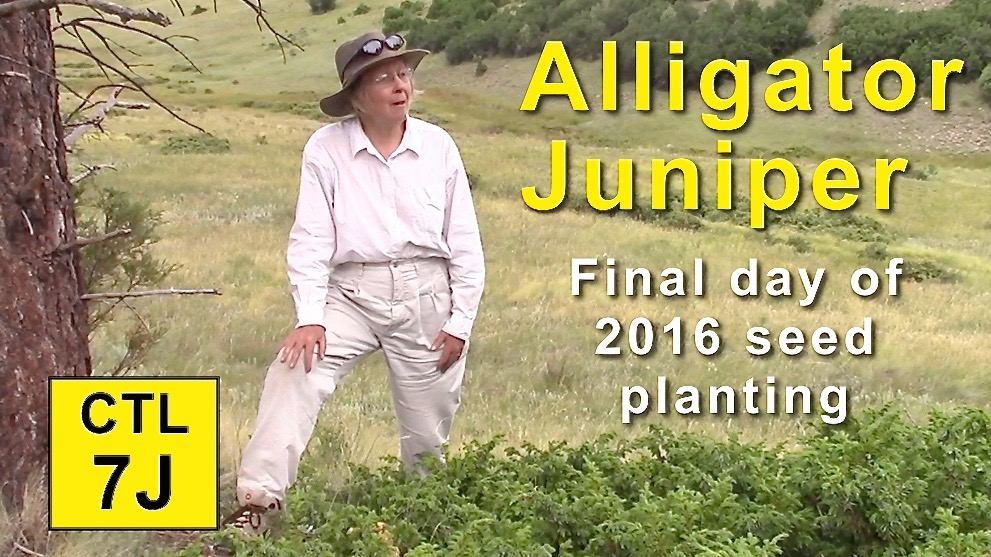 |
|
Pt. 7J: Final Day of Seed Planting (Chama NM)
Final seed plantings "elk style", with summary talk of the 4 types of experiments initiated: (1) Germination/establishment differences bt Coyote and Elk style of seed planting;
(2) Differences in slope and aspect preferences;
(3) Habitat preferences;
(4) Are there different success rates between the genotypes from 7 parent trees? Filmed August 8, 2016
31 minutes - published December 29, 2016. WATCH |
APRIL 2021 UPDATE: An extreme drought in parts of the American Southwest is resulting in all species of juniper showing significant mortality, including the highest elevation type: Alligator Juniper: "Juniper tree die-off in Arizona linked to drought, Forest Service says".
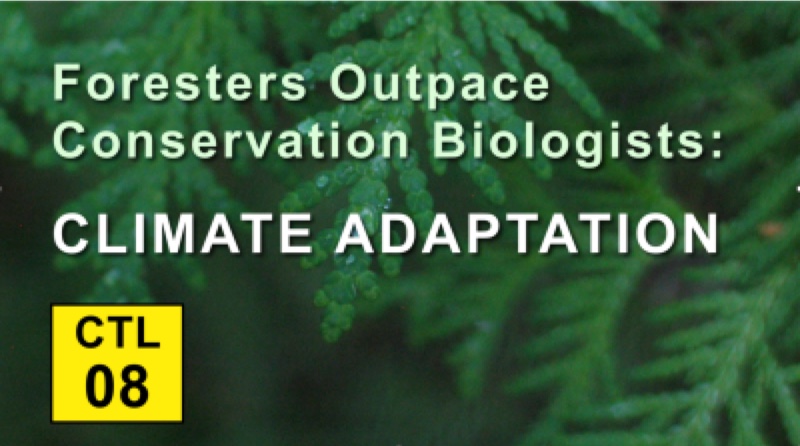 |
|
Pt. 8: FORESTERS OUTPACE CONSERVATION BIOLOGISTS IN CLIMATE ADAPTATION
Connie Barlow presented this talk September 2015 at Michigan Technological University, the School of Forest Resources and Environmental Science. Speaking to faculty and students, this was an opportunity for Barlow to present the history of the "assisted migration" controversy — highlighting the reasons why foresters have already taken actions where conservation biologists fear to tread.
60 minutes - published October 24, 2015 WATCH |
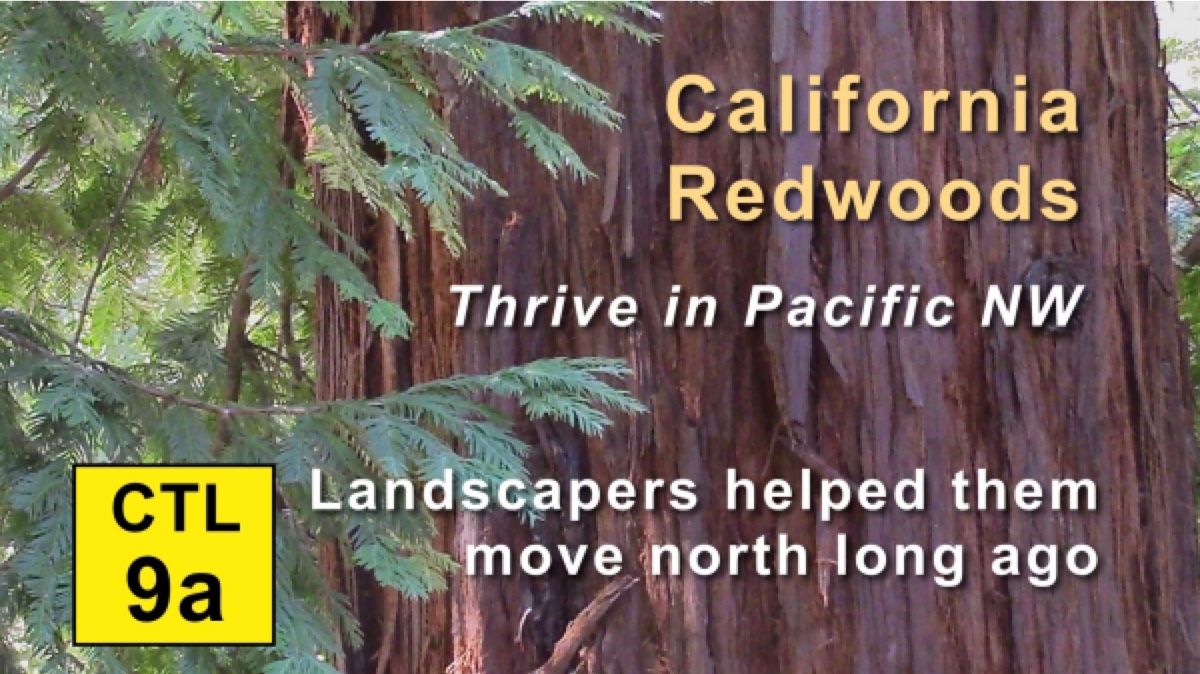 |
|
Pt. 9A: California Redwoods Thrive in Pacific NW
First video of a naturalized population of multi-age Coast Redwood trees in Washington State; north of Seattle at Hutt Park in Edmonds. This former estate included two redwood trees when it was willed to the city in the 1960s. During the last 20 years those redwoods have — with no human assistance — produced offspring from seeds, now aged 1 to 20 years, thriving in the surrounding regrowth forest.
60 minutes - published August 12, 2017 WATCH |
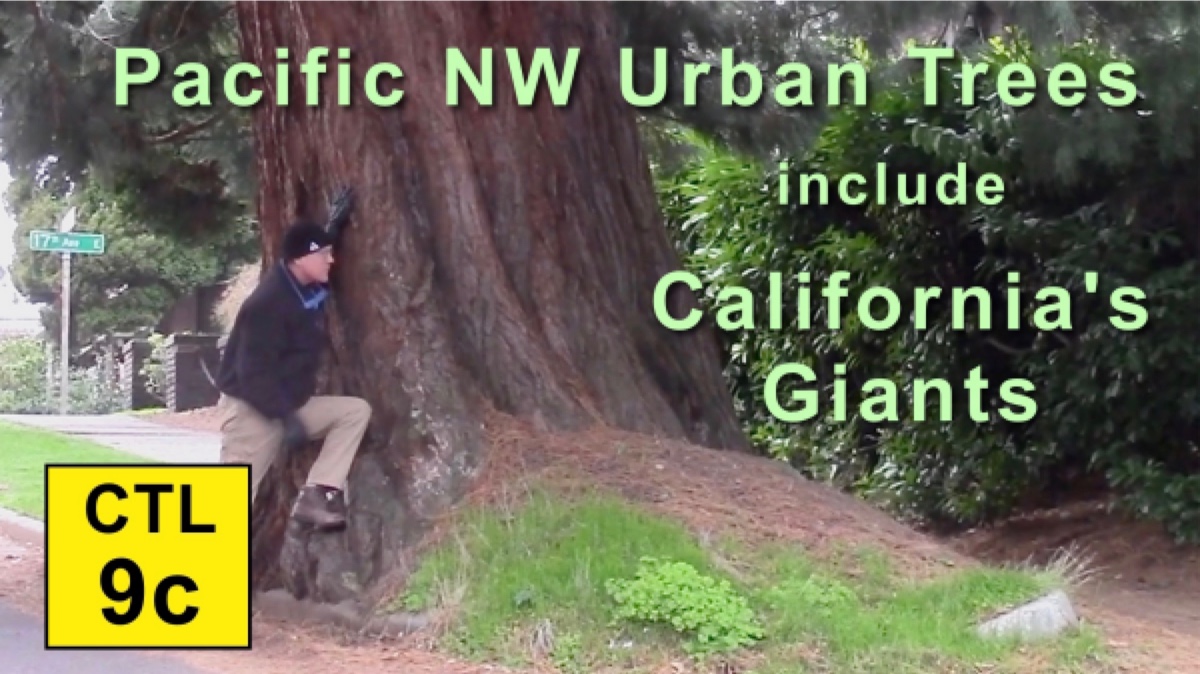 |
|
Pt. 9C - Pacific NW Urban Trees Include California's Giants
Examples of urban street tree (and estate) plantings of Coast Redwood and Giant Sequoia as examples of helpful "assisted migration" already underway. Coast Redwood may have fewer plantings owing to shallow roots that can disrupt nearby pavement. Giant Sequoia uniquely can be identified online via 3D tool of Google Maps. (Oral history important.)
44 minutes - published August 22, 2017 WATCH |
• Watch a 2019 documentary on vimeo about an old urban planting of 3 GIANT SEQUOIAS in Portland OR that a developer was trying to have cut down. Residents came out en masse, including a tree sitter. A combination of public sentiment (plus donated money) finally gave the trees permanent protection.
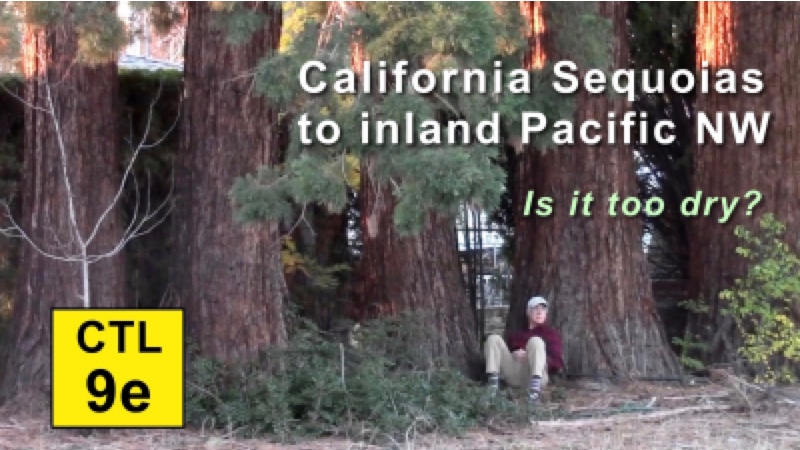 |
|
Pt. 9E - California Sequoias to Inland Pacific NW: Is it too dry?
Documentation and oral and written histories of Giant Sequoia (and Coast Redwood) growing in areas of Pacific NW inland (drier) than at the coast. Lessons: Giant Sequoia has advantage over Coast Redwood inland; importance of high water table.
36 minutes - published September 9, 2017 WATCH |
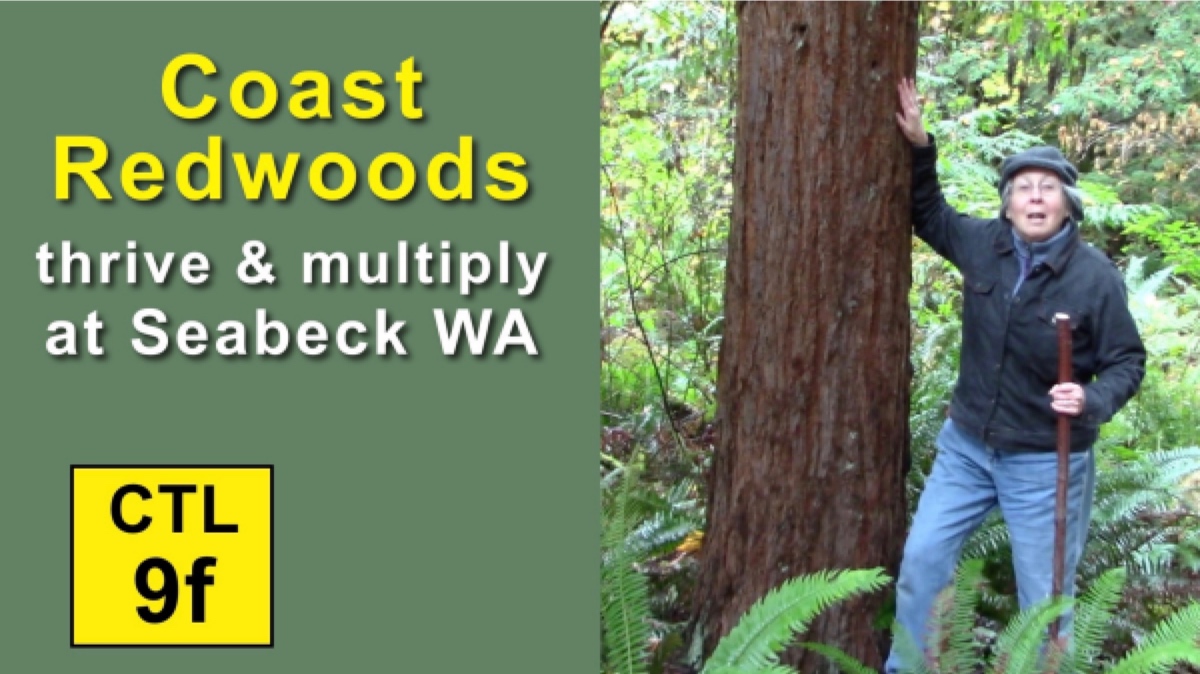 |
|
Pt. 9F - Coast Redwoods Thrive and Multiply at Seabeck, WA 2019
Crucial documentation of 1980s planting of Coast Redwoods into a Douglas-fir regrowth forest west of Seattle. Site visit by Connie Barlow October 2019 shows thrival of the in-forest plantings plus multiple age groups of evident offspring: seedlings and saplings dispersing beyond the original plantings.
61 minutes - published November 2019 WATCH |
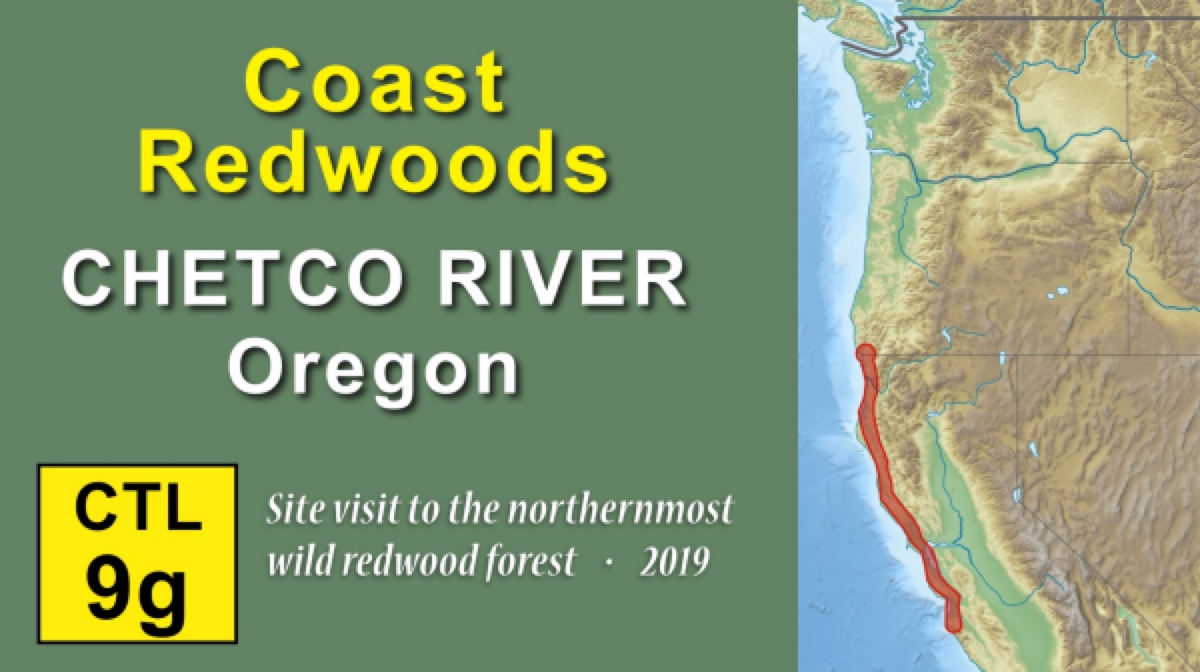 |
|
Pt. 9G - Coast Redwoods at Chetco River Oregon - 2019 site visit
Barlow video-documents a site visit to the northern-most wild grove of Coast Redwoods. While it lacks the immense tree sizes for which Redwood National Park (California) is famous, this site in sw Oregon offers hope for those weary of climate bad news. Here one finds evidence that this tallest tree species in the world can still launch new generations of seedlings into the forest.
25 minutes - published November 2019 WATCH |
NOTE: Episode 9i is likely the last episode in the Redwood series, possibly in the entire CTL series:
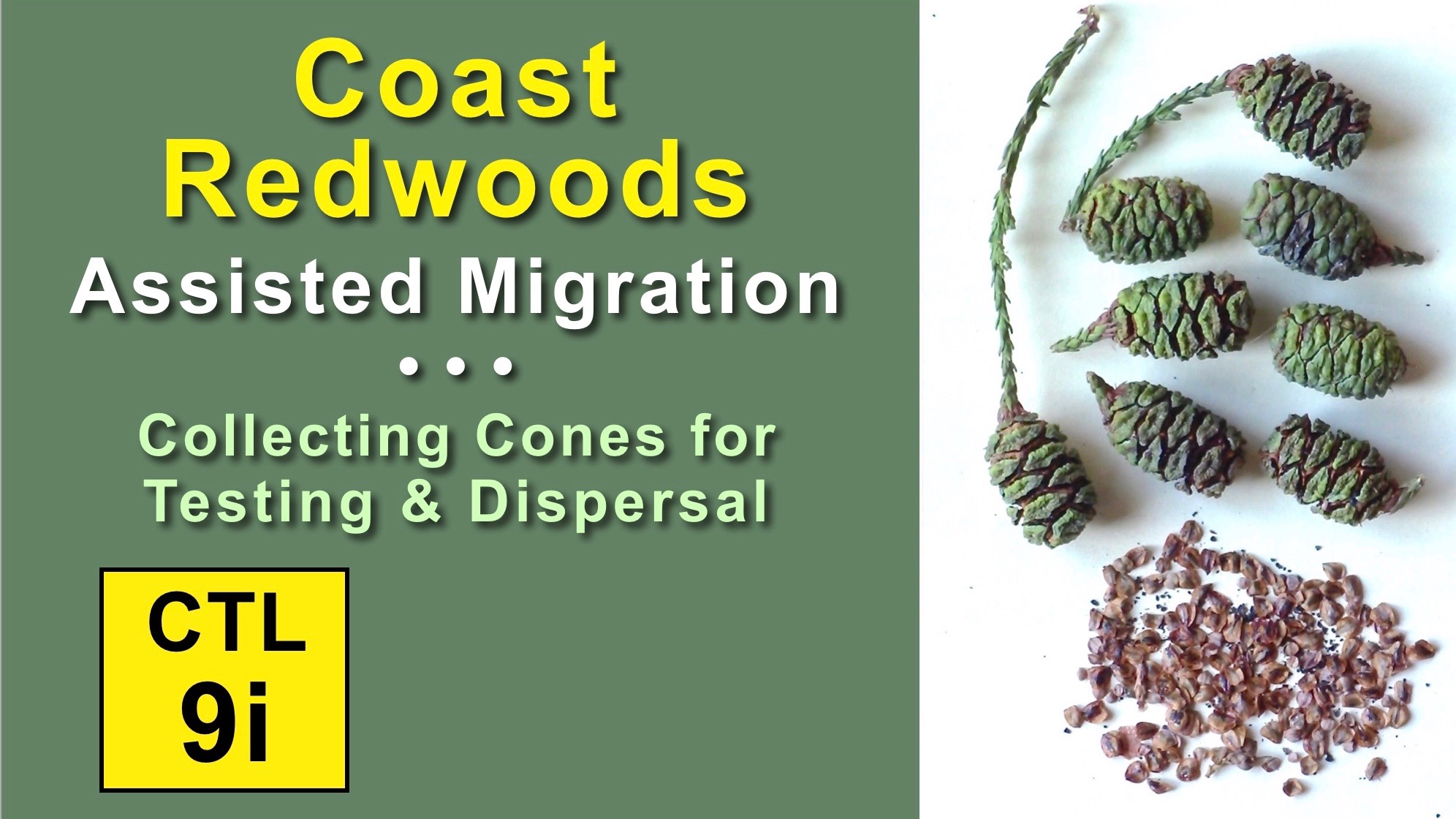 |
|
Pt. 9i - Coast Redwoods Assisted Migration: Collecting, Testing, and Dispersing Seeds Northward
Field experiences and online learning have culminated in sufficient information for citizens to launch their own efforts for easily gathering cones, testing seed viability, and dispersing seeds (as the wind would do, if given thousands of years to track climate change) into fog-rich areas of the Pacific Northwest coast. The likely best microsite: patches of tall Sword Fern beneath deciduous canopy of Big-Leaf maple.
1 hour - published March 2020 WATCH |
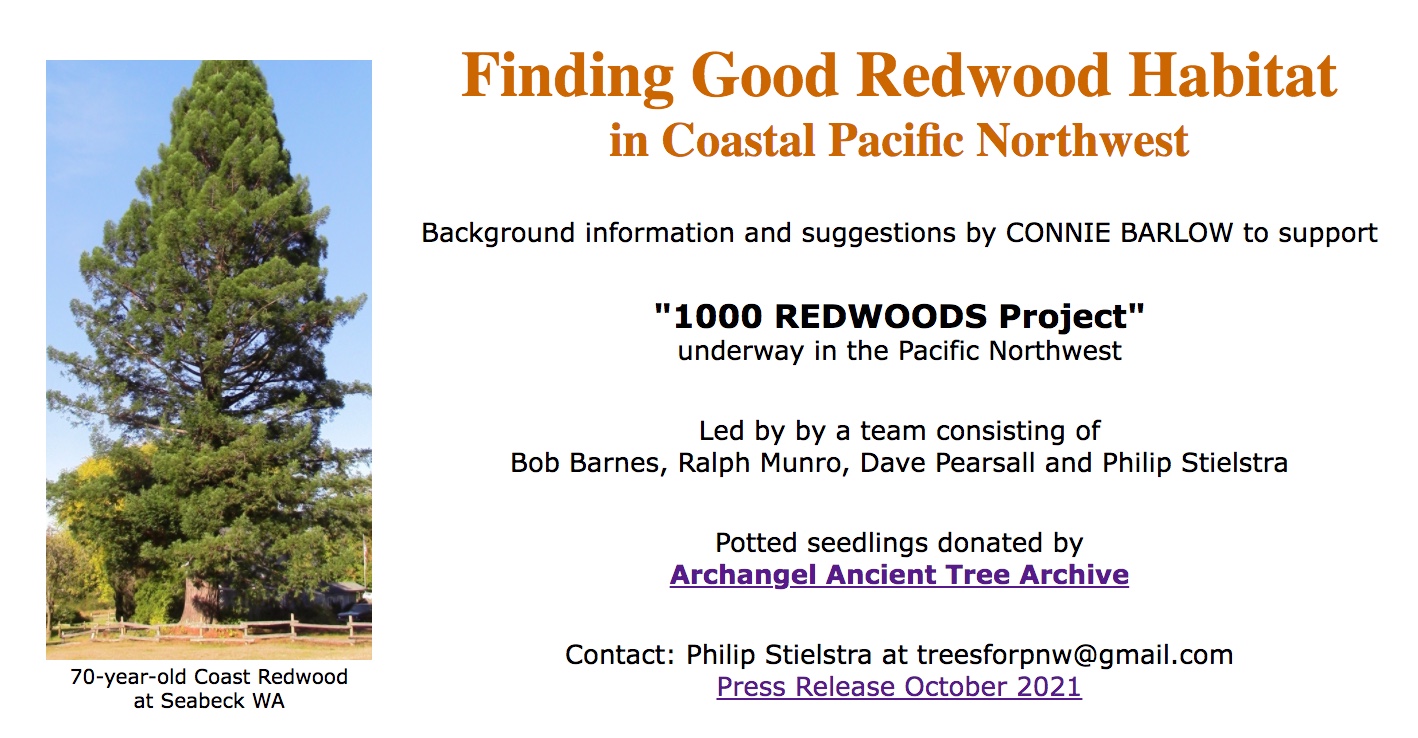 |
|
UPDATE in 2021:
Connie Barlow created a richly illustrated webpage to offer guidance for volunteer planters of Coast Redwood in the Pacific Northwest to select suitable habitat for siting the potted seedlings being donated by Archangel Ancient Tree Archive.
|
UPDATE 2022: October 2022 the Canadian Forestry Service published a 39-page report by Richard Winder et al., which I have excerpted and linked here: "Assisted Migration of Coast Redwood to Vancouver Island"
UPDATE 2022: I found a terrific website that presents hundreds of locales in the U.K. where any of the 3 species of redwoods have been planted. Some trees are giants!
Pt. 9J - Baseline Documentation of Coast Redwood Seedlings in Rockefeller Grove (n. Calif)
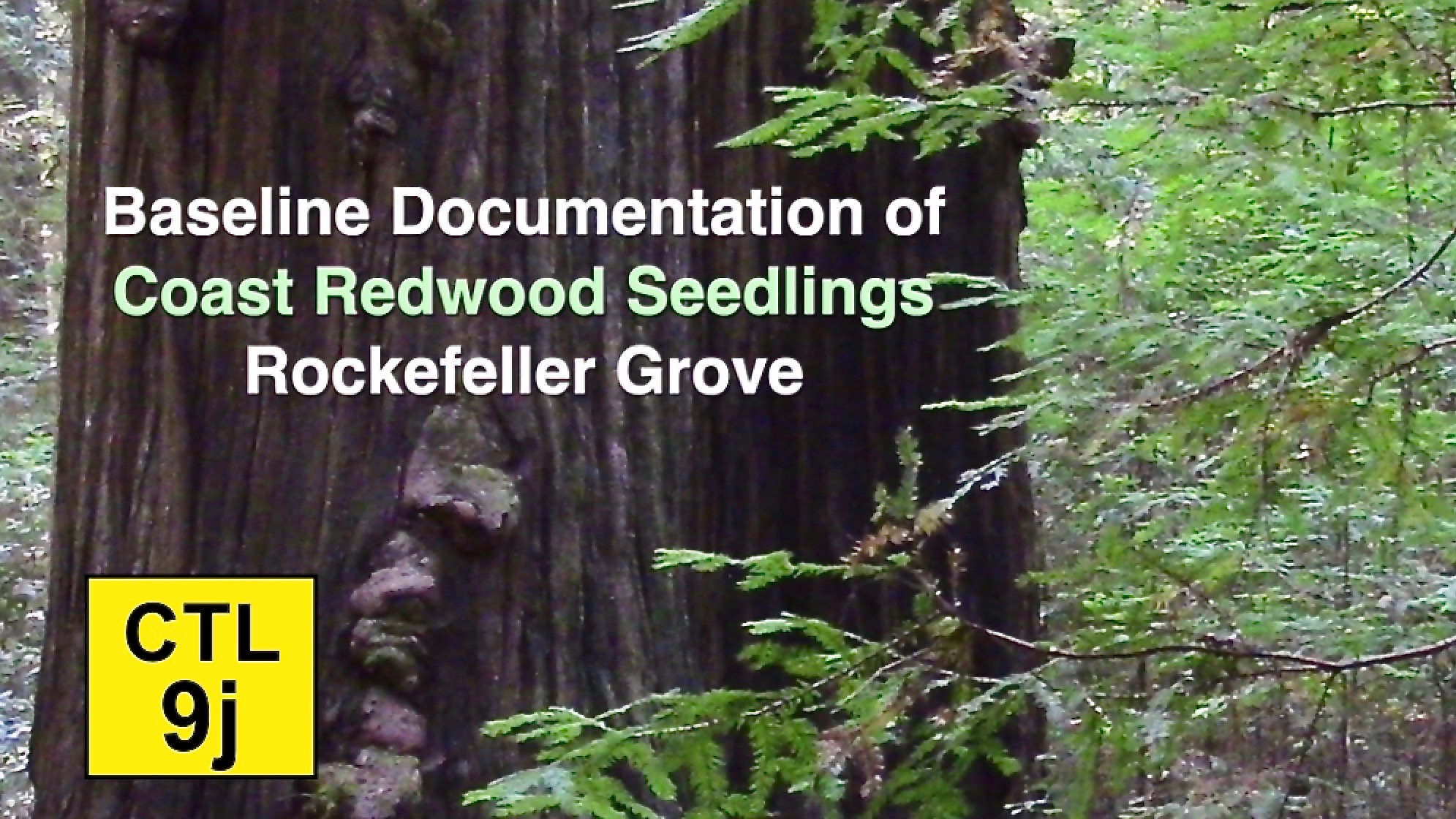 |
|
Studying redwood propensities in California is crucial for nurturing them in the Pacific Northwest. Hence, this BASELINE DOCUMENTATION of seedlings and saplings along the Big Trees Trail and the Rockefeller Loop trail.
Sample this video as you walk the trail, and interpret for yourself how even-age spurts of seedlings in response to new canopy openings will self-thin over time.
10 mins - published Feb 2024 (filmed Aug 2017) WATCH |
Florida Torreya's California Cousin Has
Clues for Ex Situ Plantings
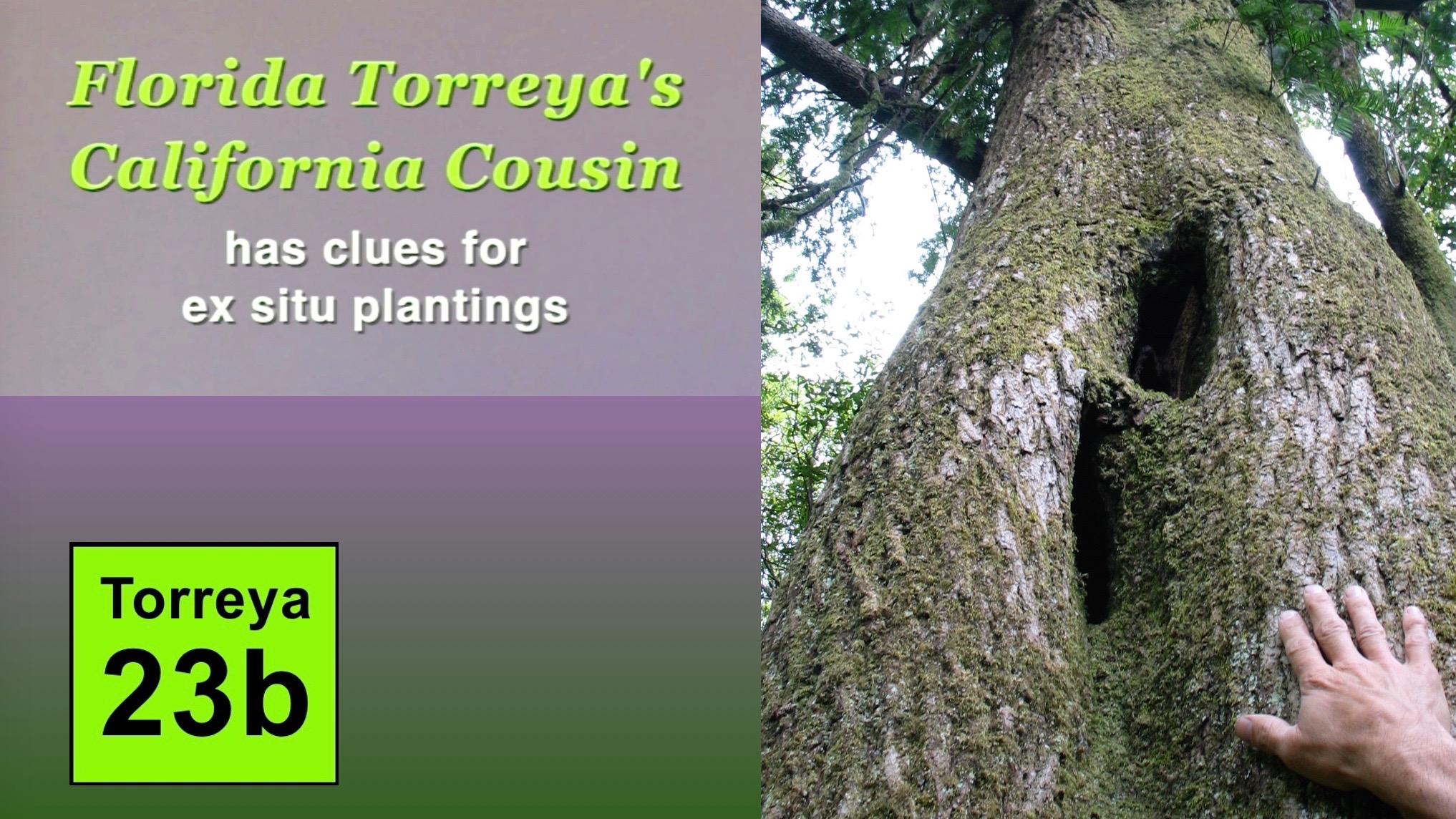 |
|
This 2-part video series was created in service of helping Torreya Guardians understand the best microsites for planting the endangered FLORIDA TORREYA northward of its tiny relictual refuge in n. Florida.
The videos can also serve as 2005 baseline documentation for understanding and eventually assisting poleward plantings of CALIFORNIA TORREYA, Torreya californica.
Filmed in 5 locales of the Coast Range and west slope of the Sierras, this is a subcanopy member of the yew family endemic to California.
Part 1 (25 minutes)
• Part 2 (27 minutes)
|
Read Connie's 2005 observational notes at: Photo-essays of California Torreyas.
• "Helping Forests Walk" series began in 2021
 |
|
Retired to her home state of Michigan, Barlow launched a new video series: "Helping Forests Walk". Episode 1 - Introduction begins this more reflective series on the topic of "assisted migration" than her 2014-2020 video series filmed across America: "Climate, Trees, and Legacy".
This new series builds upon her founding of Torreya Guardians in 2004, which was the first group to help a climate endangered tree move poleward. This series will feature traditional natural history ways of observing and interpreting as a possible bridge between indigenous and modern science.
52 minutes - published June 2021 WATCH
|
 |
|
REPOSTING of a TALK Barlow delivered September 2015 at Michigan Technological University, the School of Forest Resources and Environmental Science. It was originally posted on youtube titled, "Foresters Outpace Conservation Biologists in Climate Adaptation."
Speaking to faculty and students, this was an opportunity for Barlow to present the history of the "assisted migration" controversy — highlighting the reasons why foresters have already taken actions where conservation biologists fear to tread.
60 minutes - published October 24, 2015 WATCH |
 |
|
"Thinking Like a Yew" is the title Connie chose for the third episode of her "Helping Forests Walk" series. (It echoes Aldo Leopold's "Thinking Like a Mountain.") This video is an assemblage of forestry videos Connie took of wild yew species in western (Oregon and California) and eastern (Michigan and New York) North America. She hopes it will help colleagues in Europe and China have new ideas for assisting their own native yews in climate migration and recovering population levels signaling healthy ecological conditions.
73 minutes - published June 2021. WATCH
|
 |
|
"Helping Subcanopy Trees Migrate" features two subcanopy species of the eastern USA. Pawpaw, while having a long north-south reach in its historic range, can benefit from "assisted range expansion" northward. Florida Torreya is an endangered glacial relict for which citizens, including Connie, have done what the official recovery program implementers have been unwilling to do — restore its health by nothing more difficult than planting seeds well to the north. Indigenous values are advocated as well as the "natural history" style of observation and interpretation — which is the foundation of western science.
50 minutes - published November 2021. WATCH
|
 |
|
Is this an Old-Growth Pawpaw Patch? (Michigan, 2021)
In the previous episode, "Helping Subcanopy Trees Migrate," Connie suggested that a wild pawpaw patch she explored two months earlier has characteristics of "old growth." Here is the field footage for others to "explore" this site and make their own interpretations.
36 minutes - filmed September 9, 2021. WATCH |
 |
|
"Conifers of Colorado - Why Topoclimate Matters for Range Projections".
Connie Barlow filmed wild populations of 7 conifer tree species in 2017 — all within a few hundred yards of one another. The concept of "topocliimate" is introduced, as described in a 2021 paper. Topoclimate is a crucial consideration in highly complex topographies, such as this site in the Colorado Rockies, 9400-feet elevation. In live commentary added in 2022, Connie makes the case for "assisted migration" of Bristlecone Pine.
48 minutes - published February 2022 WATCH
|
Additional Climate-Forestry Videos by Connie Barlow
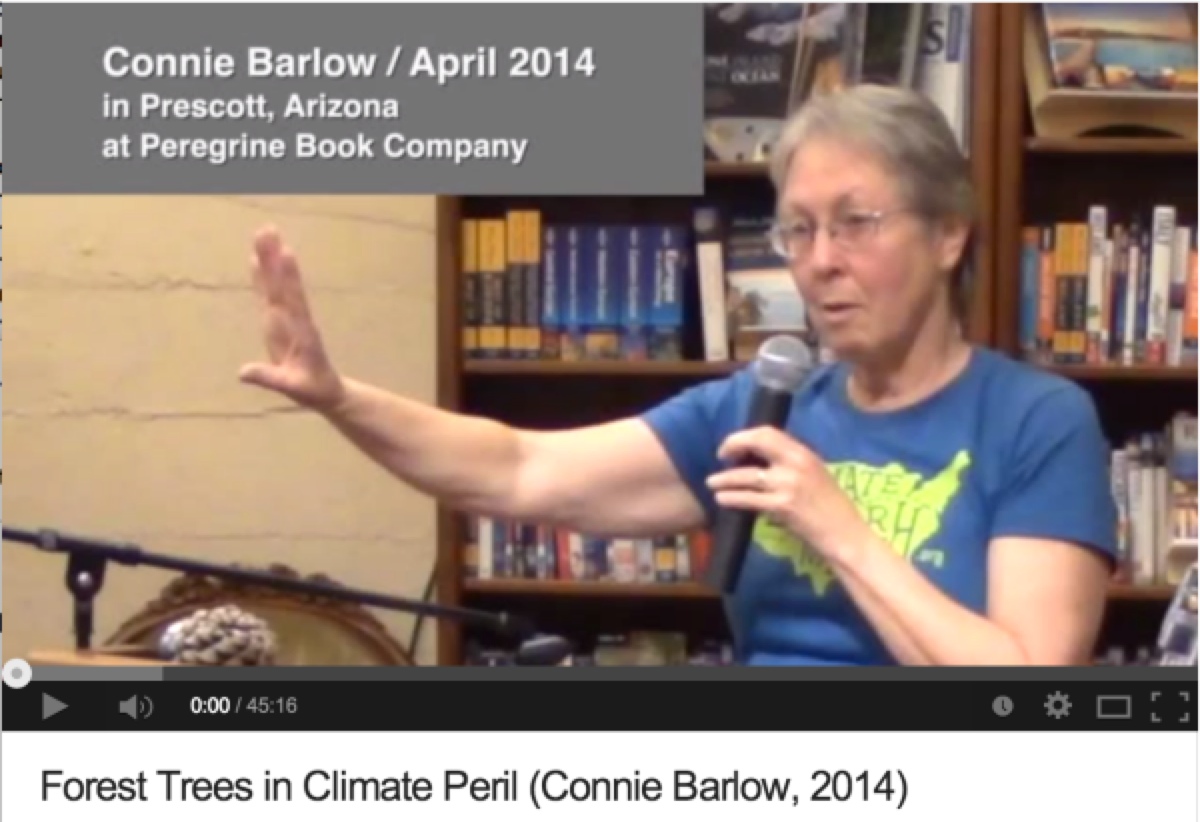
|
|
2014 VIDEO: Connie Barlow presents: "Forest Trees in Climate Peril"
A 45-minute talk that Connie delivered in Prescott, Arizona, is the single best place to begin learning how rapid climate change is endangering even common trees of American forests — and why our descendants will need to step in and help those trees disperse seeds farther north than birds and mammals can transport them.
45 minutes - published May 12, 2014. WATCH |
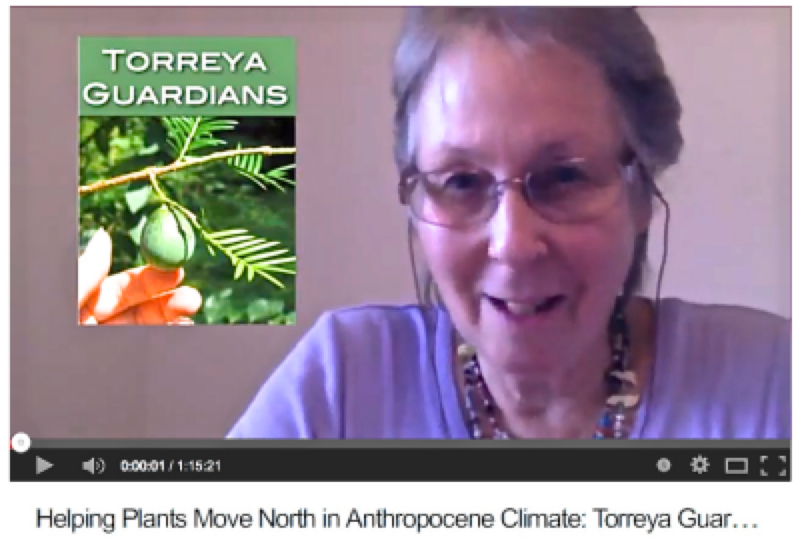 |
|
"Helping Plants Move North in the Anthropocene" was the predecessor video that led to the "Climate, Trees, and Legacy" videoseries. In July 2008, a group of citizen-naturalists (Torreya Guardians) legally acquired 31 seedlings of the most endangered conifer in the world — Torreya taxifolia (the "Florida Torreya") — and then planted the seedlings beneath wild forest canopy on two private properties in the mountains of North Carolina. Here, the founder of Torreya Guardians (Connie Barlow) reports on what they have learned thus far in this first climate-driven, human-assisted migration of a plant in the USA.
75 minutes - published November 7, 2013. WATCH |
Click for ONGOING VIDEO REPORT SERIES OF TORREYA GUARDIANS ASSISTED MIGRATION ACTIONS on the Torreya Guardians website. Samples include:
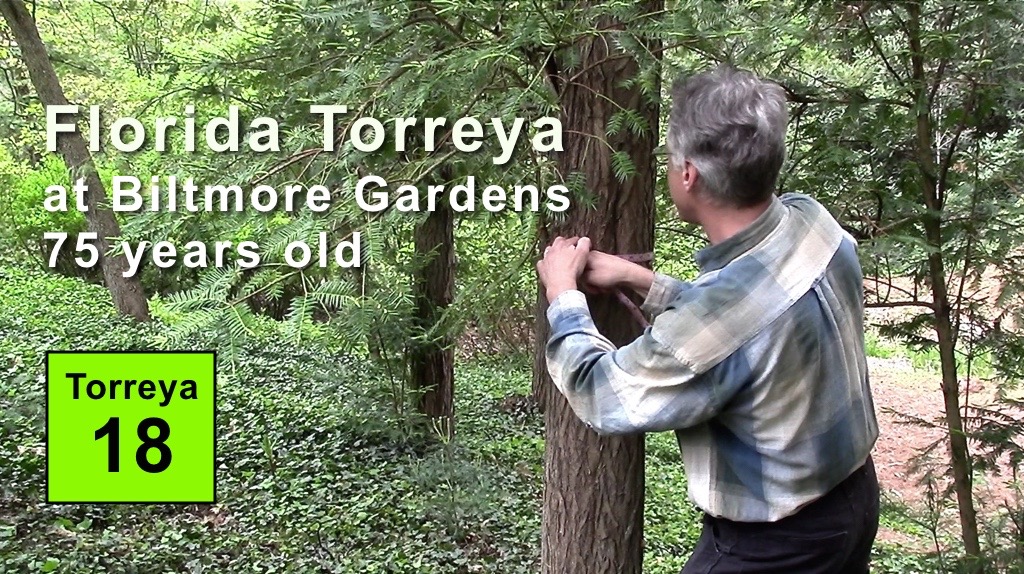 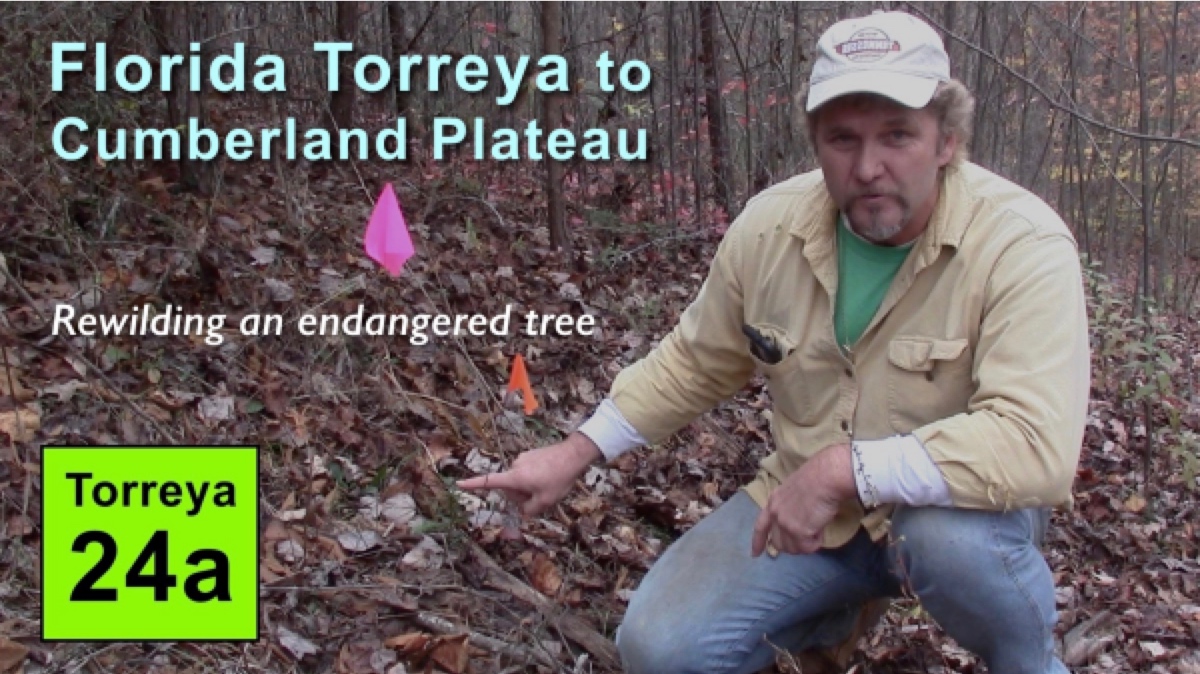 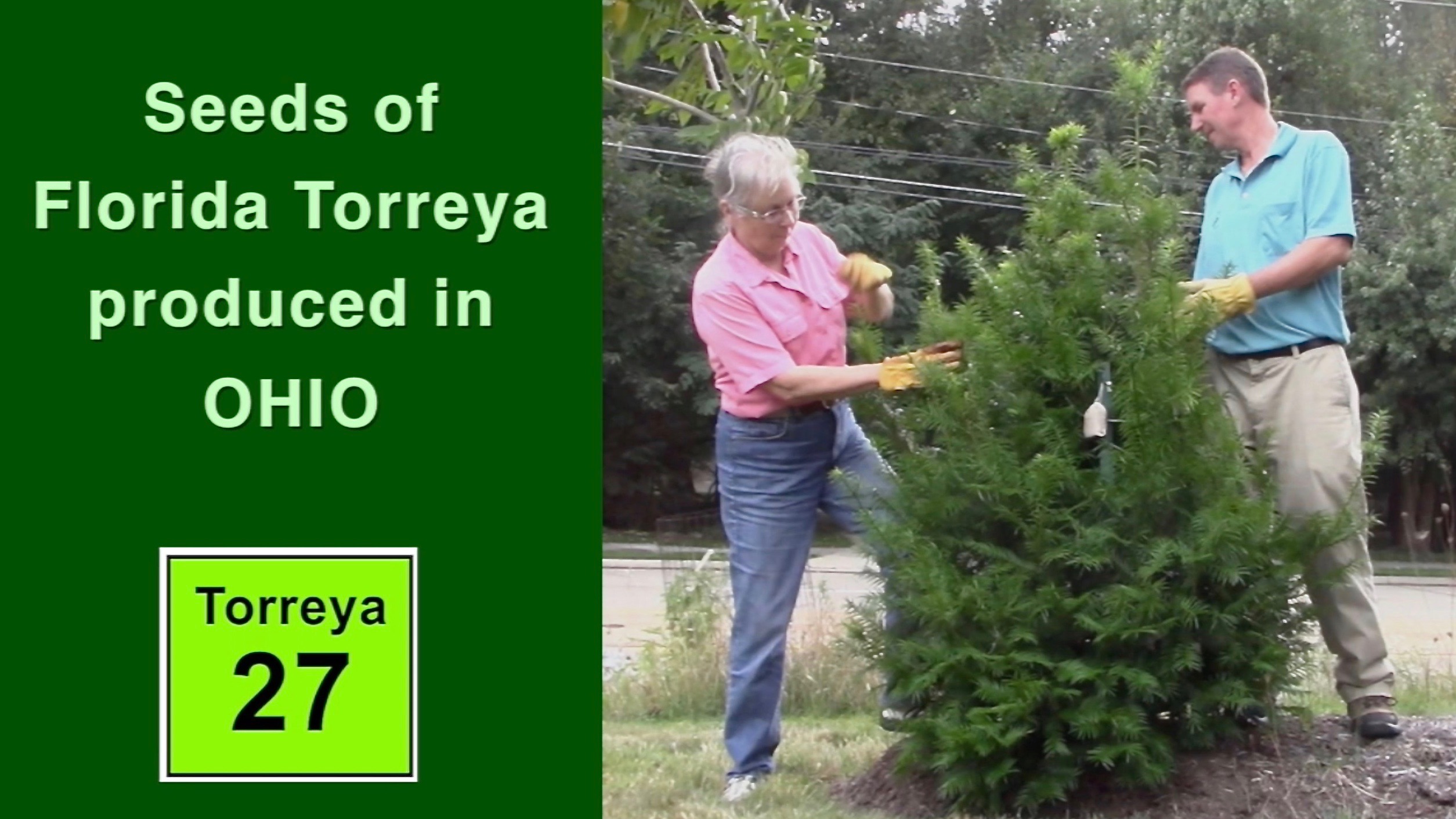 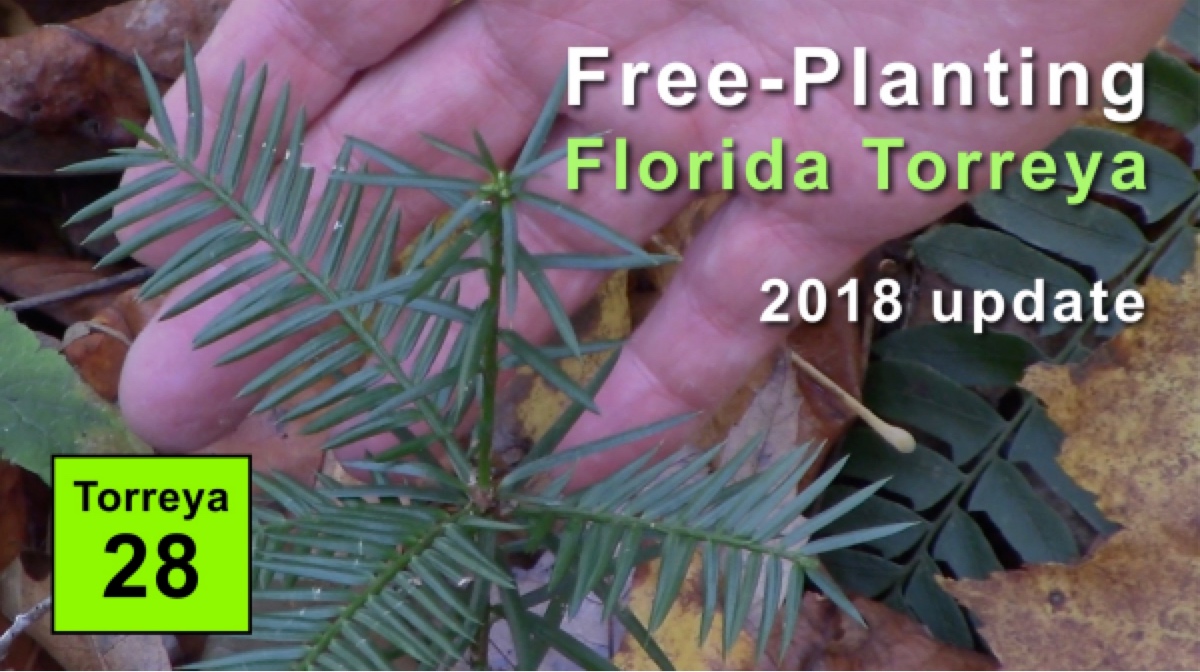
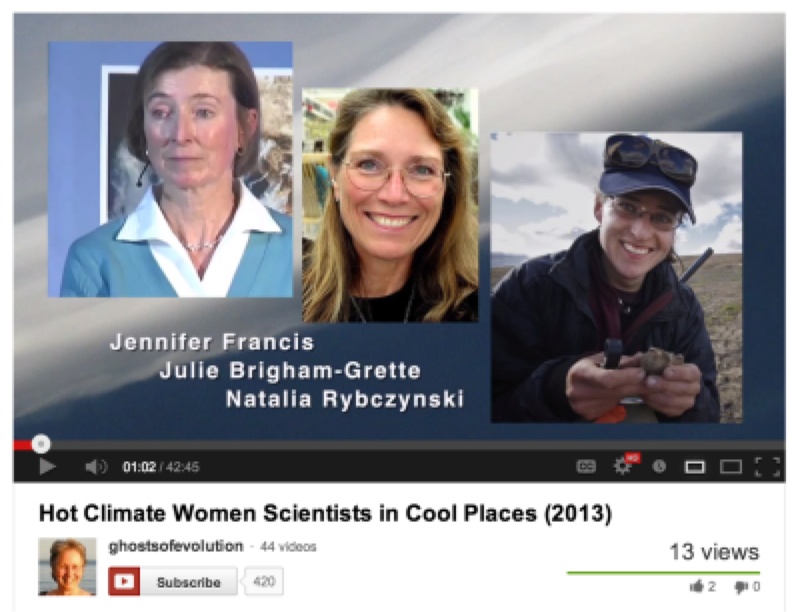 |
|
"Hot Climate Women Scientists in Cool Places"
Connie Barlow volunteers some of her time to climate activism by doing what she does best: reporting on the science and creating videos. In this new 42-minute Youtube video, Connie leads viewers through an enhanced understanding of polar ice melt, a changing jet stream, and new discoveries in paleoclimates by excerpting the richly illustrated and powerful 2013 videos by four women in climate science: Jennifer Francis, Julie Brigham-Grette, Natalia Rybczynski, and Lisa Graumlich. Michael Dowd embeds this video in his HuffPo blog here.
43 minutes - published May 22, 2013. WATCH |
RETURN TO HOME PAGE
|





















